Contemporary Human Resource Practices for Employee Retention and Engagement
VerifiedAdded on 2023/06/14
|28
|11140
|218
AI Summary
This dissertation explores the importance of contemporary human resource practices for employee retention and engagement. It covers the background, research aim, objectives, questions, rationale, significance, and thesis structure. The literature review discusses HRM practices and strategies for employee retention. The research methodology covers research type, design, philosophy, approach, data collection, analysis, ethical considerations, reliability, validity, and limitations. The data analysis chapter examines the impact of HRM practices on employee retention and engagement. The findings and discussion chapter evaluates the project themes and key findings. The conclusion and recommendations chapter summarizes the study and provides recommendations for improving HR practices. Subject: Business, Course Code: N/A, Course Name: N/A, College/University: N/A
Contribute Materials
Your contribution can guide someone’s learning journey. Share your
documents today.
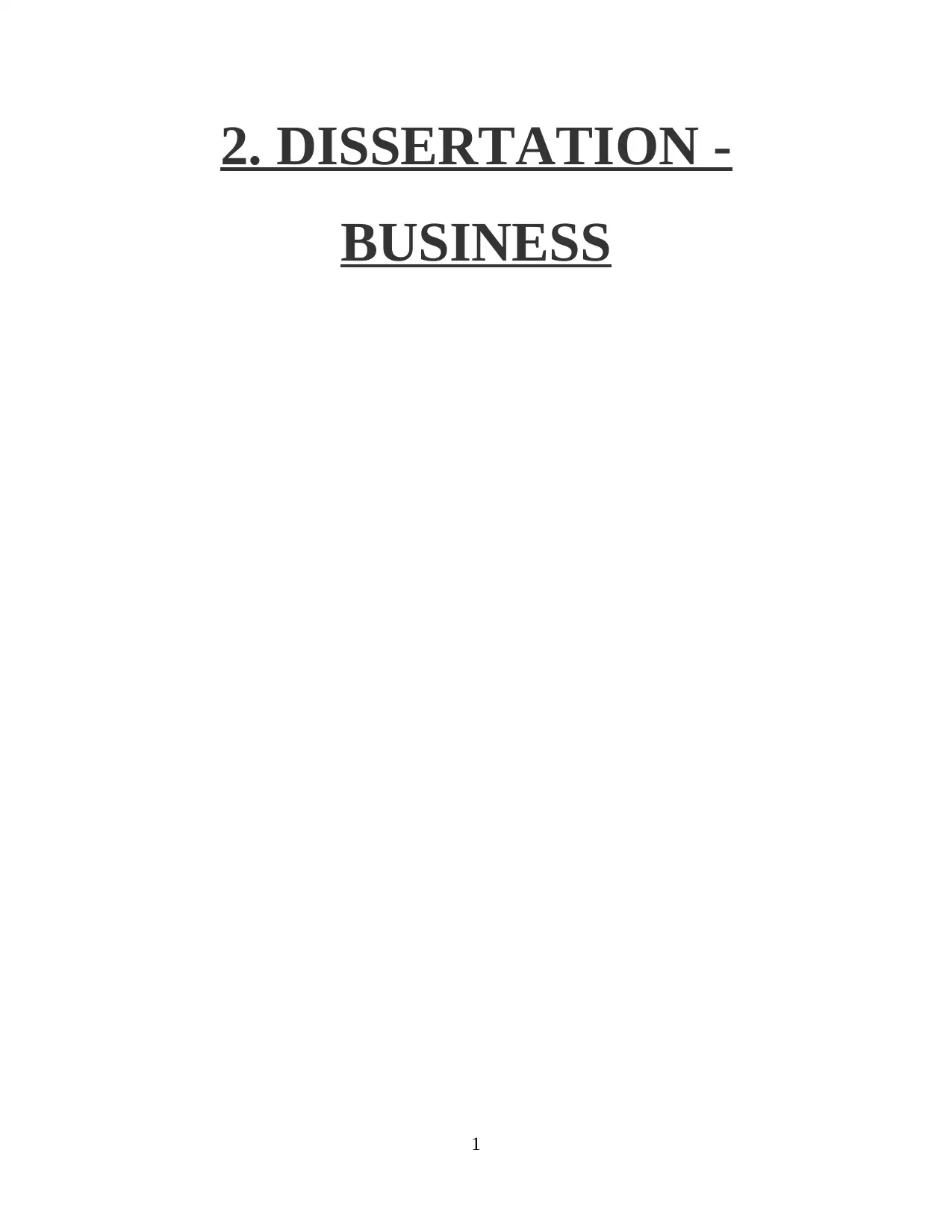
2. DISSERTATION -
BUSINESS
1
BUSINESS
1
Secure Best Marks with AI Grader
Need help grading? Try our AI Grader for instant feedback on your assignments.
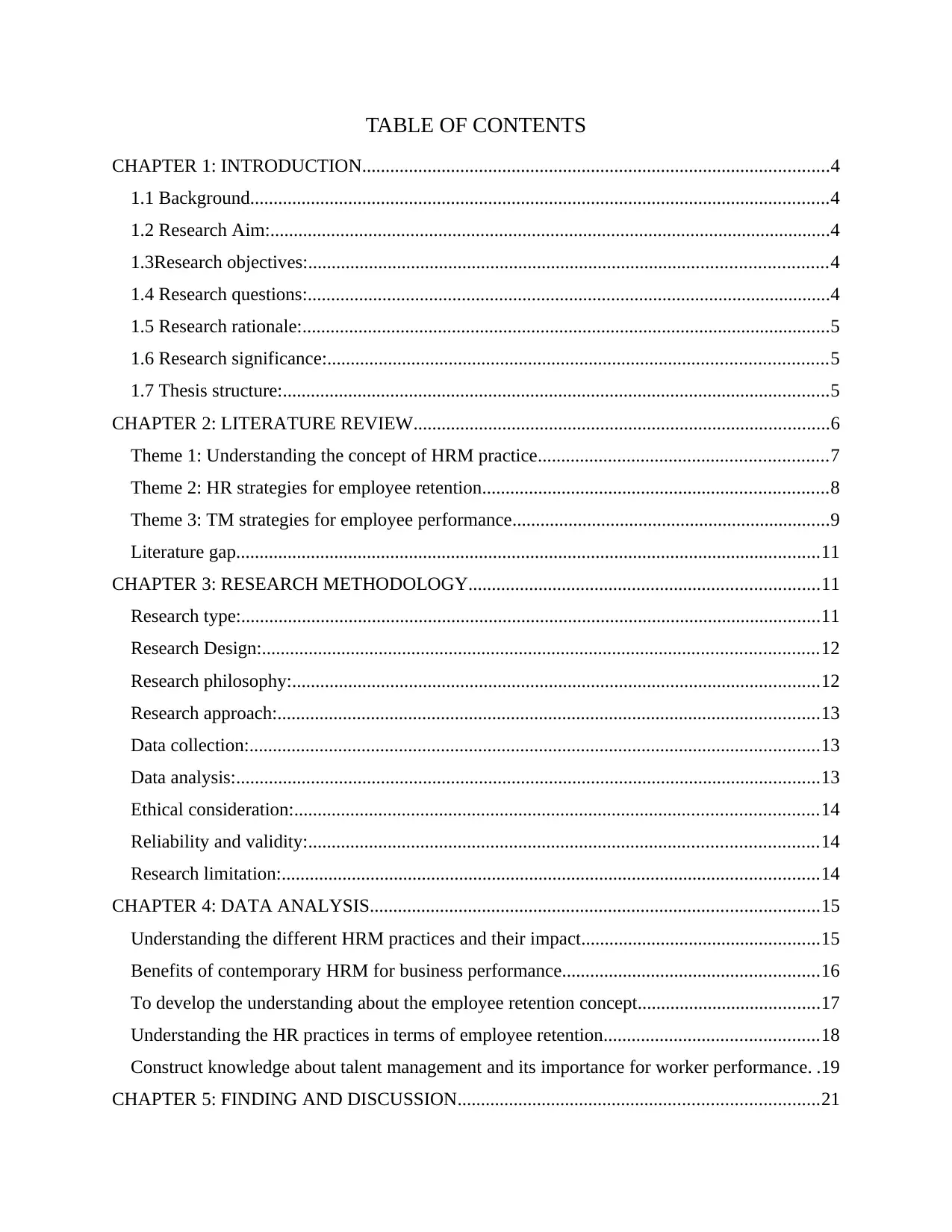
TABLE OF CONTENTS
CHAPTER 1: INTRODUCTION....................................................................................................4
1.1 Background............................................................................................................................4
1.2 Research Aim:........................................................................................................................4
1.3Research objectives:...............................................................................................................4
1.4 Research questions:................................................................................................................4
1.5 Research rationale:.................................................................................................................5
1.6 Research significance:...........................................................................................................5
1.7 Thesis structure:.....................................................................................................................5
CHAPTER 2: LITERATURE REVIEW.........................................................................................6
Theme 1: Understanding the concept of HRM practice..............................................................7
Theme 2: HR strategies for employee retention..........................................................................8
Theme 3: TM strategies for employee performance....................................................................9
Literature gap.............................................................................................................................11
CHAPTER 3: RESEARCH METHODOLOGY...........................................................................11
Research type:............................................................................................................................11
Research Design:.......................................................................................................................12
Research philosophy:.................................................................................................................12
Research approach:....................................................................................................................13
Data collection:..........................................................................................................................13
Data analysis:.............................................................................................................................13
Ethical consideration:................................................................................................................14
Reliability and validity:.............................................................................................................14
Research limitation:...................................................................................................................14
CHAPTER 4: DATA ANALYSIS................................................................................................15
Understanding the different HRM practices and their impact...................................................15
Benefits of contemporary HRM for business performance.......................................................16
To develop the understanding about the employee retention concept.......................................17
Understanding the HR practices in terms of employee retention..............................................18
Construct knowledge about talent management and its importance for worker performance. .19
CHAPTER 5: FINDING AND DISCUSSION.............................................................................21
CHAPTER 1: INTRODUCTION....................................................................................................4
1.1 Background............................................................................................................................4
1.2 Research Aim:........................................................................................................................4
1.3Research objectives:...............................................................................................................4
1.4 Research questions:................................................................................................................4
1.5 Research rationale:.................................................................................................................5
1.6 Research significance:...........................................................................................................5
1.7 Thesis structure:.....................................................................................................................5
CHAPTER 2: LITERATURE REVIEW.........................................................................................6
Theme 1: Understanding the concept of HRM practice..............................................................7
Theme 2: HR strategies for employee retention..........................................................................8
Theme 3: TM strategies for employee performance....................................................................9
Literature gap.............................................................................................................................11
CHAPTER 3: RESEARCH METHODOLOGY...........................................................................11
Research type:............................................................................................................................11
Research Design:.......................................................................................................................12
Research philosophy:.................................................................................................................12
Research approach:....................................................................................................................13
Data collection:..........................................................................................................................13
Data analysis:.............................................................................................................................13
Ethical consideration:................................................................................................................14
Reliability and validity:.............................................................................................................14
Research limitation:...................................................................................................................14
CHAPTER 4: DATA ANALYSIS................................................................................................15
Understanding the different HRM practices and their impact...................................................15
Benefits of contemporary HRM for business performance.......................................................16
To develop the understanding about the employee retention concept.......................................17
Understanding the HR practices in terms of employee retention..............................................18
Construct knowledge about talent management and its importance for worker performance. .19
CHAPTER 5: FINDING AND DISCUSSION.............................................................................21
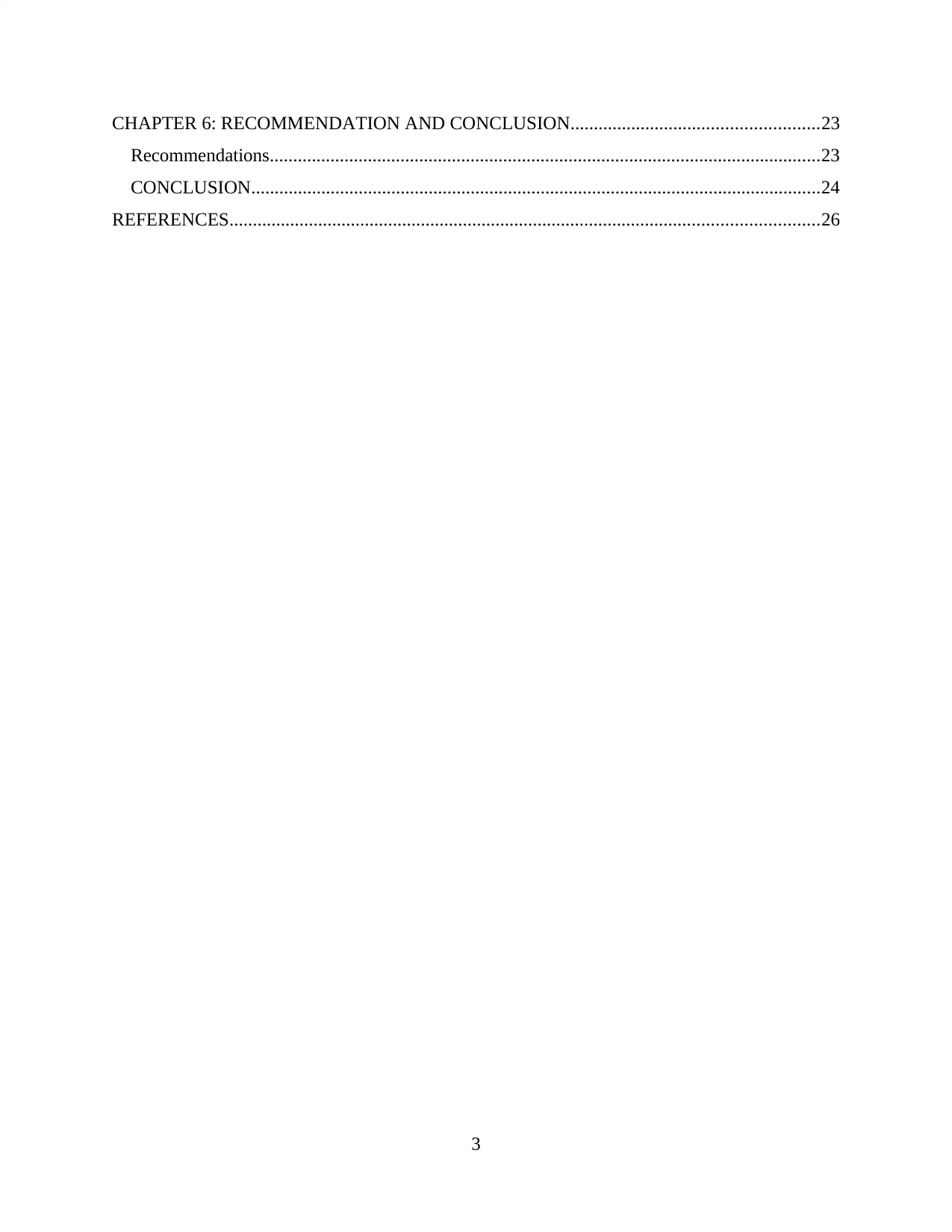
CHAPTER 6: RECOMMENDATION AND CONCLUSION.....................................................23
Recommendations......................................................................................................................23
CONCLUSION..........................................................................................................................24
REFERENCES..............................................................................................................................26
3
Recommendations......................................................................................................................23
CONCLUSION..........................................................................................................................24
REFERENCES..............................................................................................................................26
3
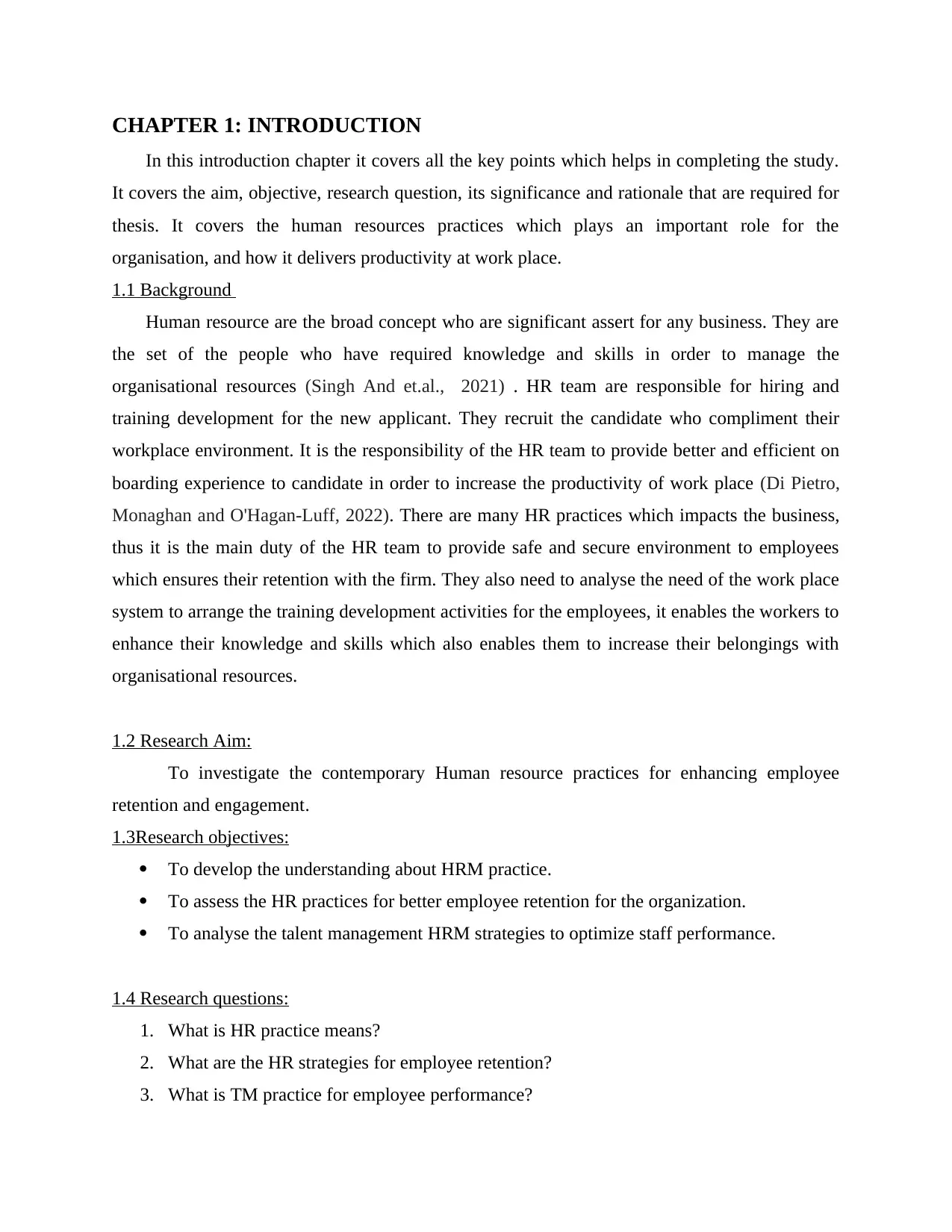
CHAPTER 1: INTRODUCTION
In this introduction chapter it covers all the key points which helps in completing the study.
It covers the aim, objective, research question, its significance and rationale that are required for
thesis. It covers the human resources practices which plays an important role for the
organisation, and how it delivers productivity at work place.
1.1 Background
Human resource are the broad concept who are significant assert for any business. They are
the set of the people who have required knowledge and skills in order to manage the
organisational resources (Singh And et.al., 2021) . HR team are responsible for hiring and
training development for the new applicant. They recruit the candidate who compliment their
workplace environment. It is the responsibility of the HR team to provide better and efficient on
boarding experience to candidate in order to increase the productivity of work place (Di Pietro,
Monaghan and O'Hagan‐Luff, 2022). There are many HR practices which impacts the business,
thus it is the main duty of the HR team to provide safe and secure environment to employees
which ensures their retention with the firm. They also need to analyse the need of the work place
system to arrange the training development activities for the employees, it enables the workers to
enhance their knowledge and skills which also enables them to increase their belongings with
organisational resources.
1.2 Research Aim:
To investigate the contemporary Human resource practices for enhancing employee
retention and engagement.
1.3Research objectives:
To develop the understanding about HRM practice.
To assess the HR practices for better employee retention for the organization.
To analyse the talent management HRM strategies to optimize staff performance.
1.4 Research questions:
1. What is HR practice means?
2. What are the HR strategies for employee retention?
3. What is TM practice for employee performance?
In this introduction chapter it covers all the key points which helps in completing the study.
It covers the aim, objective, research question, its significance and rationale that are required for
thesis. It covers the human resources practices which plays an important role for the
organisation, and how it delivers productivity at work place.
1.1 Background
Human resource are the broad concept who are significant assert for any business. They are
the set of the people who have required knowledge and skills in order to manage the
organisational resources (Singh And et.al., 2021) . HR team are responsible for hiring and
training development for the new applicant. They recruit the candidate who compliment their
workplace environment. It is the responsibility of the HR team to provide better and efficient on
boarding experience to candidate in order to increase the productivity of work place (Di Pietro,
Monaghan and O'Hagan‐Luff, 2022). There are many HR practices which impacts the business,
thus it is the main duty of the HR team to provide safe and secure environment to employees
which ensures their retention with the firm. They also need to analyse the need of the work place
system to arrange the training development activities for the employees, it enables the workers to
enhance their knowledge and skills which also enables them to increase their belongings with
organisational resources.
1.2 Research Aim:
To investigate the contemporary Human resource practices for enhancing employee
retention and engagement.
1.3Research objectives:
To develop the understanding about HRM practice.
To assess the HR practices for better employee retention for the organization.
To analyse the talent management HRM strategies to optimize staff performance.
1.4 Research questions:
1. What is HR practice means?
2. What are the HR strategies for employee retention?
3. What is TM practice for employee performance?
Secure Best Marks with AI Grader
Need help grading? Try our AI Grader for instant feedback on your assignments.
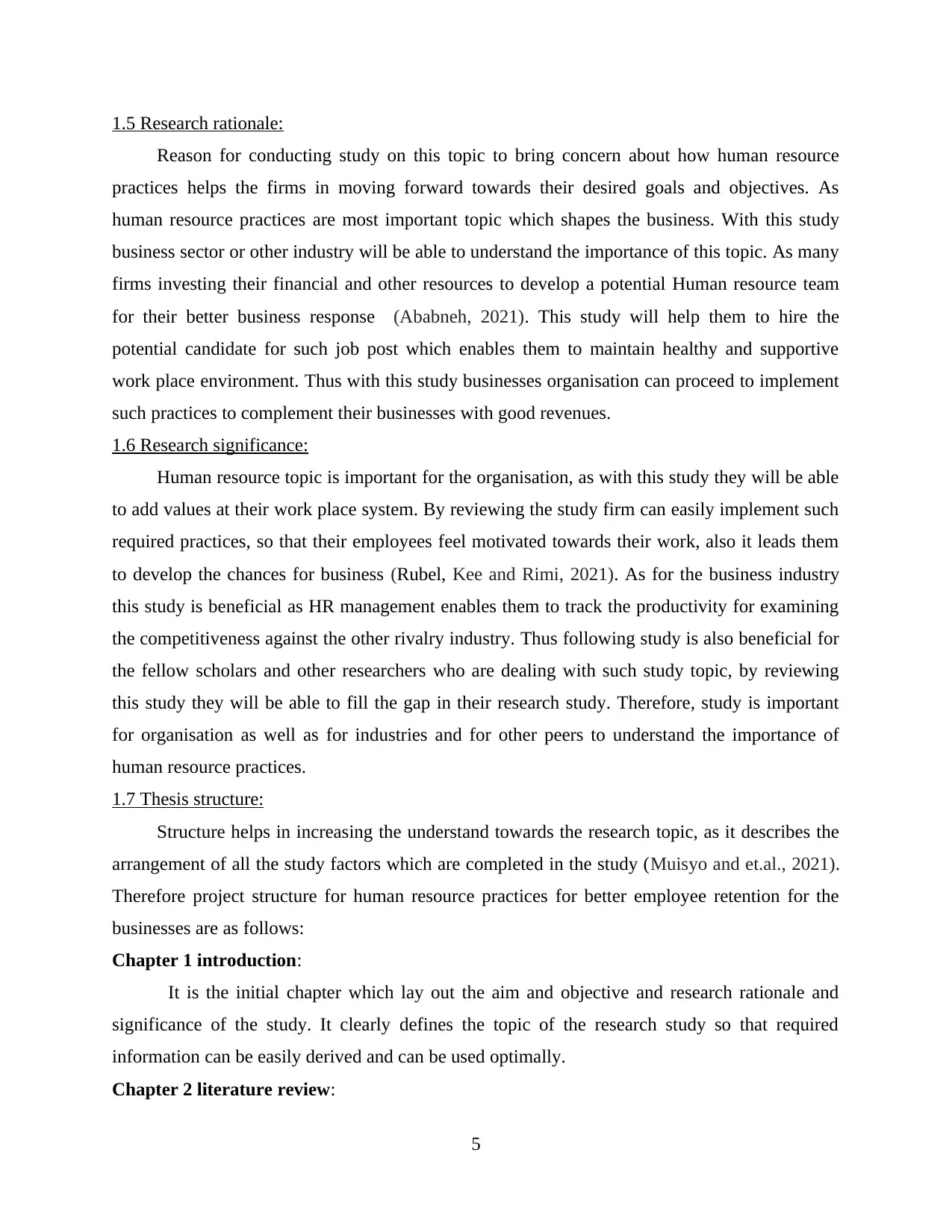
1.5 Research rationale:
Reason for conducting study on this topic to bring concern about how human resource
practices helps the firms in moving forward towards their desired goals and objectives. As
human resource practices are most important topic which shapes the business. With this study
business sector or other industry will be able to understand the importance of this topic. As many
firms investing their financial and other resources to develop a potential Human resource team
for their better business response (Ababneh, 2021). This study will help them to hire the
potential candidate for such job post which enables them to maintain healthy and supportive
work place environment. Thus with this study businesses organisation can proceed to implement
such practices to complement their businesses with good revenues.
1.6 Research significance:
Human resource topic is important for the organisation, as with this study they will be able
to add values at their work place system. By reviewing the study firm can easily implement such
required practices, so that their employees feel motivated towards their work, also it leads them
to develop the chances for business (Rubel, Kee and Rimi, 2021). As for the business industry
this study is beneficial as HR management enables them to track the productivity for examining
the competitiveness against the other rivalry industry. Thus following study is also beneficial for
the fellow scholars and other researchers who are dealing with such study topic, by reviewing
this study they will be able to fill the gap in their research study. Therefore, study is important
for organisation as well as for industries and for other peers to understand the importance of
human resource practices.
1.7 Thesis structure:
Structure helps in increasing the understand towards the research topic, as it describes the
arrangement of all the study factors which are completed in the study (Muisyo and et.al., 2021).
Therefore project structure for human resource practices for better employee retention for the
businesses are as follows:
Chapter 1 introduction:
It is the initial chapter which lay out the aim and objective and research rationale and
significance of the study. It clearly defines the topic of the research study so that required
information can be easily derived and can be used optimally.
Chapter 2 literature review:
5
Reason for conducting study on this topic to bring concern about how human resource
practices helps the firms in moving forward towards their desired goals and objectives. As
human resource practices are most important topic which shapes the business. With this study
business sector or other industry will be able to understand the importance of this topic. As many
firms investing their financial and other resources to develop a potential Human resource team
for their better business response (Ababneh, 2021). This study will help them to hire the
potential candidate for such job post which enables them to maintain healthy and supportive
work place environment. Thus with this study businesses organisation can proceed to implement
such practices to complement their businesses with good revenues.
1.6 Research significance:
Human resource topic is important for the organisation, as with this study they will be able
to add values at their work place system. By reviewing the study firm can easily implement such
required practices, so that their employees feel motivated towards their work, also it leads them
to develop the chances for business (Rubel, Kee and Rimi, 2021). As for the business industry
this study is beneficial as HR management enables them to track the productivity for examining
the competitiveness against the other rivalry industry. Thus following study is also beneficial for
the fellow scholars and other researchers who are dealing with such study topic, by reviewing
this study they will be able to fill the gap in their research study. Therefore, study is important
for organisation as well as for industries and for other peers to understand the importance of
human resource practices.
1.7 Thesis structure:
Structure helps in increasing the understand towards the research topic, as it describes the
arrangement of all the study factors which are completed in the study (Muisyo and et.al., 2021).
Therefore project structure for human resource practices for better employee retention for the
businesses are as follows:
Chapter 1 introduction:
It is the initial chapter which lay out the aim and objective and research rationale and
significance of the study. It clearly defines the topic of the research study so that required
information can be easily derived and can be used optimally.
Chapter 2 literature review:
5

It is the second chapter which involves the review of articles of the other author. It
explains the theme which is based on the research objectives, and involves the arguments of the
authors. Themes are made on understanding the concept of the human resource practices,
suitable human resource strategies for employee retention.
Chapter 3 Research methodology:
Third chapter is research methodology which describes the approaches in which the study
is conducted as this study describe the various methodologies such as research type, philosophy,
approaches, data collection and other methods to complete the study.
Chapter 4 Data analysis:
Data analysis chapter describe the processing of the data which also involves the chart
and graphs and interpretation of the data so that individual can easily understand the study topic.
Chapter 5 Discussion and findings:
This chapter will discuss the project themes and evaluate the data, It also involves the key
findings which can increase the productivity of the study. With this discussion data viewer can
easily proceed to make changes, as organisations can easily adapt the Human resource practices
for improving their work place system and to improve their business productivity.
Chapter 6 Conclusion and recommendations:
It is the last chapter which summarised all the factors which have been discussed
throughout the project. It concluded all the study aspect in concise manner, so that reader can
easily understand what things are included in the study. Lastly it describes the recommendations
which can be made in order to increase the productivity, and involve some key points regarding
HR practice and its importance to business functionality.
CHAPTER 2: LITERATURE REVIEW
Literature review refer as the part of the academic writing which illustrate the knowledge
and comprehension about the specific topic. It also involves the critical evaluation of the things;
thus it is termed as the literature review (Alruwaili, 2018). LR can be written as thesis,
dissertation and as the research paper, which helps in deriving the work that are related to the
existing knowledge. It helps in study as to develop the great clarity and concentration in the
research problem also improvise the research methodology, it also enhances the knowledge in
research area and examine or contextualise the complete searching. Therefore, this chapter
explains the theme which is based on the research objectives, and involves the arguments of the
authors. Themes are made on understanding the concept of the human resource practices,
suitable human resource strategies for employee retention.
Chapter 3 Research methodology:
Third chapter is research methodology which describes the approaches in which the study
is conducted as this study describe the various methodologies such as research type, philosophy,
approaches, data collection and other methods to complete the study.
Chapter 4 Data analysis:
Data analysis chapter describe the processing of the data which also involves the chart
and graphs and interpretation of the data so that individual can easily understand the study topic.
Chapter 5 Discussion and findings:
This chapter will discuss the project themes and evaluate the data, It also involves the key
findings which can increase the productivity of the study. With this discussion data viewer can
easily proceed to make changes, as organisations can easily adapt the Human resource practices
for improving their work place system and to improve their business productivity.
Chapter 6 Conclusion and recommendations:
It is the last chapter which summarised all the factors which have been discussed
throughout the project. It concluded all the study aspect in concise manner, so that reader can
easily understand what things are included in the study. Lastly it describes the recommendations
which can be made in order to increase the productivity, and involve some key points regarding
HR practice and its importance to business functionality.
CHAPTER 2: LITERATURE REVIEW
Literature review refer as the part of the academic writing which illustrate the knowledge
and comprehension about the specific topic. It also involves the critical evaluation of the things;
thus it is termed as the literature review (Alruwaili, 2018). LR can be written as thesis,
dissertation and as the research paper, which helps in deriving the work that are related to the
existing knowledge. It helps in study as to develop the great clarity and concentration in the
research problem also improvise the research methodology, it also enhances the knowledge in
research area and examine or contextualise the complete searching. Therefore, this chapter
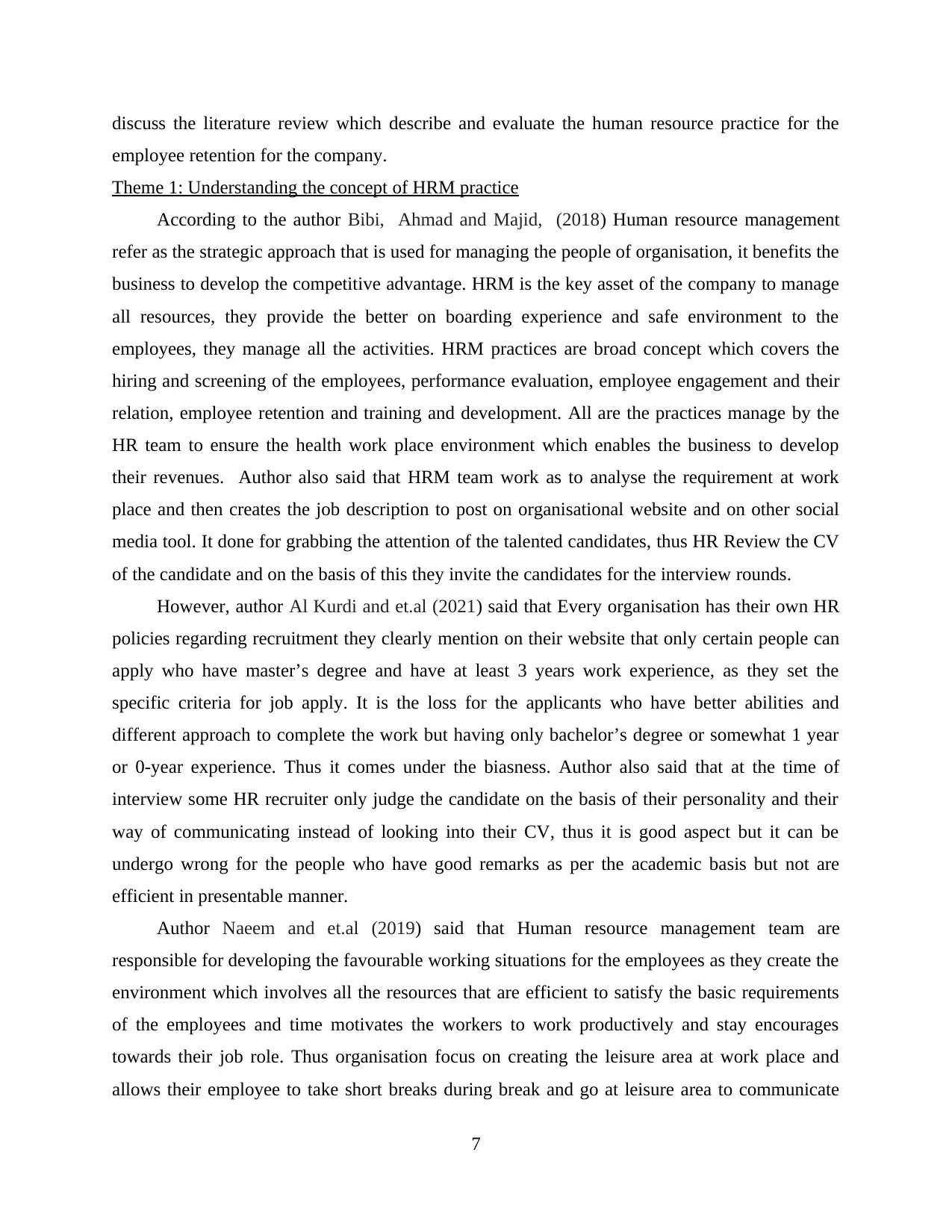
discuss the literature review which describe and evaluate the human resource practice for the
employee retention for the company.
Theme 1: Understanding the concept of HRM practice
According to the author Bibi, Ahmad and Majid, (2018) Human resource management
refer as the strategic approach that is used for managing the people of organisation, it benefits the
business to develop the competitive advantage. HRM is the key asset of the company to manage
all resources, they provide the better on boarding experience and safe environment to the
employees, they manage all the activities. HRM practices are broad concept which covers the
hiring and screening of the employees, performance evaluation, employee engagement and their
relation, employee retention and training and development. All are the practices manage by the
HR team to ensure the health work place environment which enables the business to develop
their revenues. Author also said that HRM team work as to analyse the requirement at work
place and then creates the job description to post on organisational website and on other social
media tool. It done for grabbing the attention of the talented candidates, thus HR Review the CV
of the candidate and on the basis of this they invite the candidates for the interview rounds.
However, author Al Kurdi and et.al (2021) said that Every organisation has their own HR
policies regarding recruitment they clearly mention on their website that only certain people can
apply who have master’s degree and have at least 3 years work experience, as they set the
specific criteria for job apply. It is the loss for the applicants who have better abilities and
different approach to complete the work but having only bachelor’s degree or somewhat 1 year
or 0-year experience. Thus it comes under the biasness. Author also said that at the time of
interview some HR recruiter only judge the candidate on the basis of their personality and their
way of communicating instead of looking into their CV, thus it is good aspect but it can be
undergo wrong for the people who have good remarks as per the academic basis but not are
efficient in presentable manner.
Author Naeem and et.al (2019) said that Human resource management team are
responsible for developing the favourable working situations for the employees as they create the
environment which involves all the resources that are efficient to satisfy the basic requirements
of the employees and time motivates the workers to work productively and stay encourages
towards their job role. Thus organisation focus on creating the leisure area at work place and
allows their employee to take short breaks during break and go at leisure area to communicate
7
employee retention for the company.
Theme 1: Understanding the concept of HRM practice
According to the author Bibi, Ahmad and Majid, (2018) Human resource management
refer as the strategic approach that is used for managing the people of organisation, it benefits the
business to develop the competitive advantage. HRM is the key asset of the company to manage
all resources, they provide the better on boarding experience and safe environment to the
employees, they manage all the activities. HRM practices are broad concept which covers the
hiring and screening of the employees, performance evaluation, employee engagement and their
relation, employee retention and training and development. All are the practices manage by the
HR team to ensure the health work place environment which enables the business to develop
their revenues. Author also said that HRM team work as to analyse the requirement at work
place and then creates the job description to post on organisational website and on other social
media tool. It done for grabbing the attention of the talented candidates, thus HR Review the CV
of the candidate and on the basis of this they invite the candidates for the interview rounds.
However, author Al Kurdi and et.al (2021) said that Every organisation has their own HR
policies regarding recruitment they clearly mention on their website that only certain people can
apply who have master’s degree and have at least 3 years work experience, as they set the
specific criteria for job apply. It is the loss for the applicants who have better abilities and
different approach to complete the work but having only bachelor’s degree or somewhat 1 year
or 0-year experience. Thus it comes under the biasness. Author also said that at the time of
interview some HR recruiter only judge the candidate on the basis of their personality and their
way of communicating instead of looking into their CV, thus it is good aspect but it can be
undergo wrong for the people who have good remarks as per the academic basis but not are
efficient in presentable manner.
Author Naeem and et.al (2019) said that Human resource management team are
responsible for developing the favourable working situations for the employees as they create the
environment which involves all the resources that are efficient to satisfy the basic requirements
of the employees and time motivates the workers to work productively and stay encourages
towards their job role. Thus organisation focus on creating the leisure area at work place and
allows their employee to take short breaks during break and go at leisure area to communicate
7
Paraphrase This Document
Need a fresh take? Get an instant paraphrase of this document with our AI Paraphraser
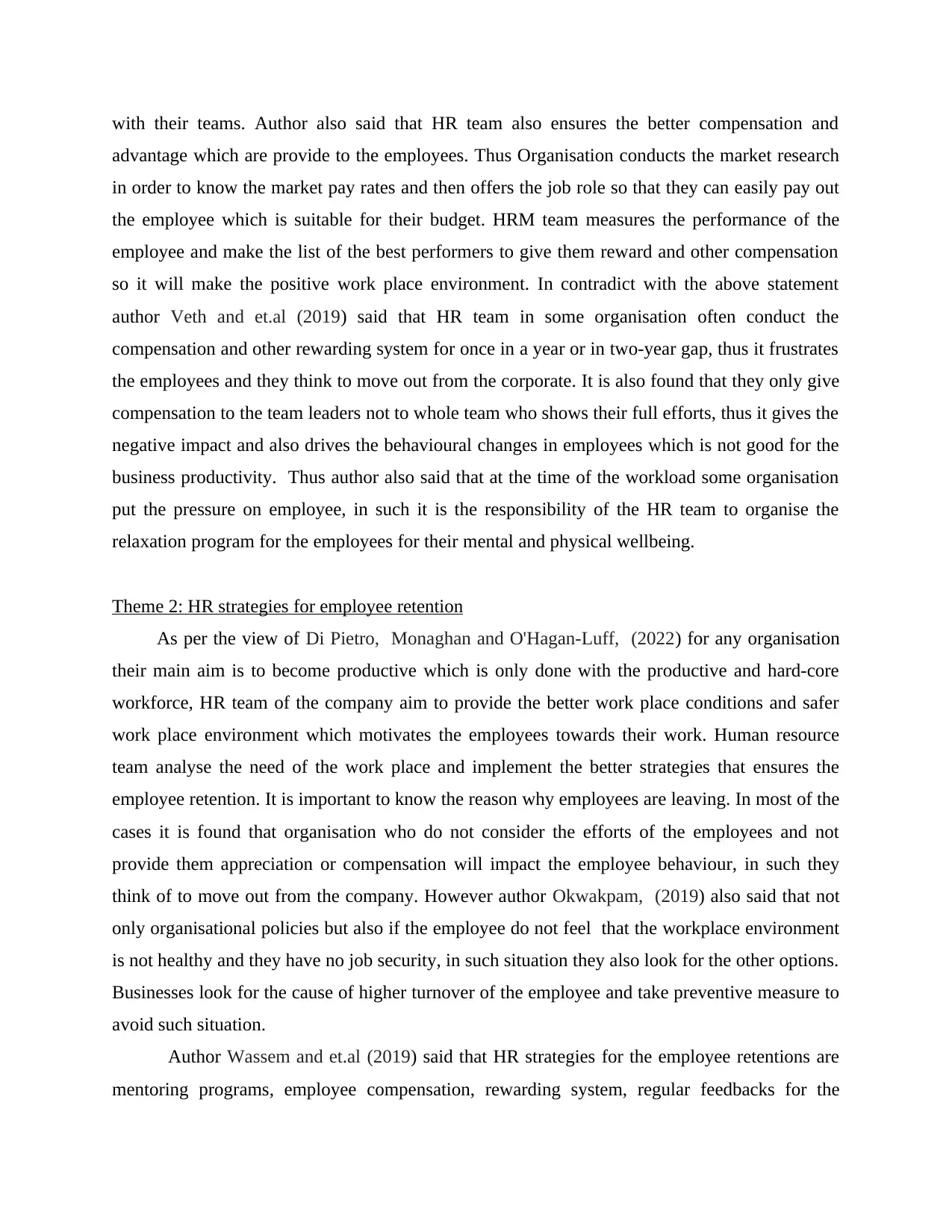
with their teams. Author also said that HR team also ensures the better compensation and
advantage which are provide to the employees. Thus Organisation conducts the market research
in order to know the market pay rates and then offers the job role so that they can easily pay out
the employee which is suitable for their budget. HRM team measures the performance of the
employee and make the list of the best performers to give them reward and other compensation
so it will make the positive work place environment. In contradict with the above statement
author Veth and et.al (2019) said that HR team in some organisation often conduct the
compensation and other rewarding system for once in a year or in two-year gap, thus it frustrates
the employees and they think to move out from the corporate. It is also found that they only give
compensation to the team leaders not to whole team who shows their full efforts, thus it gives the
negative impact and also drives the behavioural changes in employees which is not good for the
business productivity. Thus author also said that at the time of the workload some organisation
put the pressure on employee, in such it is the responsibility of the HR team to organise the
relaxation program for the employees for their mental and physical wellbeing.
Theme 2: HR strategies for employee retention
As per the view of Di Pietro, Monaghan and O'Hagan‐Luff, (2022) for any organisation
their main aim is to become productive which is only done with the productive and hard-core
workforce, HR team of the company aim to provide the better work place conditions and safer
work place environment which motivates the employees towards their work. Human resource
team analyse the need of the work place and implement the better strategies that ensures the
employee retention. It is important to know the reason why employees are leaving. In most of the
cases it is found that organisation who do not consider the efforts of the employees and not
provide them appreciation or compensation will impact the employee behaviour, in such they
think of to move out from the company. However author Okwakpam, (2019) also said that not
only organisational policies but also if the employee do not feel that the workplace environment
is not healthy and they have no job security, in such situation they also look for the other options.
Businesses look for the cause of higher turnover of the employee and take preventive measure to
avoid such situation.
Author Wassem and et.al (2019) said that HR strategies for the employee retentions are
mentoring programs, employee compensation, rewarding system, regular feedbacks for the
advantage which are provide to the employees. Thus Organisation conducts the market research
in order to know the market pay rates and then offers the job role so that they can easily pay out
the employee which is suitable for their budget. HRM team measures the performance of the
employee and make the list of the best performers to give them reward and other compensation
so it will make the positive work place environment. In contradict with the above statement
author Veth and et.al (2019) said that HR team in some organisation often conduct the
compensation and other rewarding system for once in a year or in two-year gap, thus it frustrates
the employees and they think to move out from the corporate. It is also found that they only give
compensation to the team leaders not to whole team who shows their full efforts, thus it gives the
negative impact and also drives the behavioural changes in employees which is not good for the
business productivity. Thus author also said that at the time of the workload some organisation
put the pressure on employee, in such it is the responsibility of the HR team to organise the
relaxation program for the employees for their mental and physical wellbeing.
Theme 2: HR strategies for employee retention
As per the view of Di Pietro, Monaghan and O'Hagan‐Luff, (2022) for any organisation
their main aim is to become productive which is only done with the productive and hard-core
workforce, HR team of the company aim to provide the better work place conditions and safer
work place environment which motivates the employees towards their work. Human resource
team analyse the need of the work place and implement the better strategies that ensures the
employee retention. It is important to know the reason why employees are leaving. In most of the
cases it is found that organisation who do not consider the efforts of the employees and not
provide them appreciation or compensation will impact the employee behaviour, in such they
think of to move out from the company. However author Okwakpam, (2019) also said that not
only organisational policies but also if the employee do not feel that the workplace environment
is not healthy and they have no job security, in such situation they also look for the other options.
Businesses look for the cause of higher turnover of the employee and take preventive measure to
avoid such situation.
Author Wassem and et.al (2019) said that HR strategies for the employee retentions are
mentoring programs, employee compensation, rewarding system, regular feedbacks for the
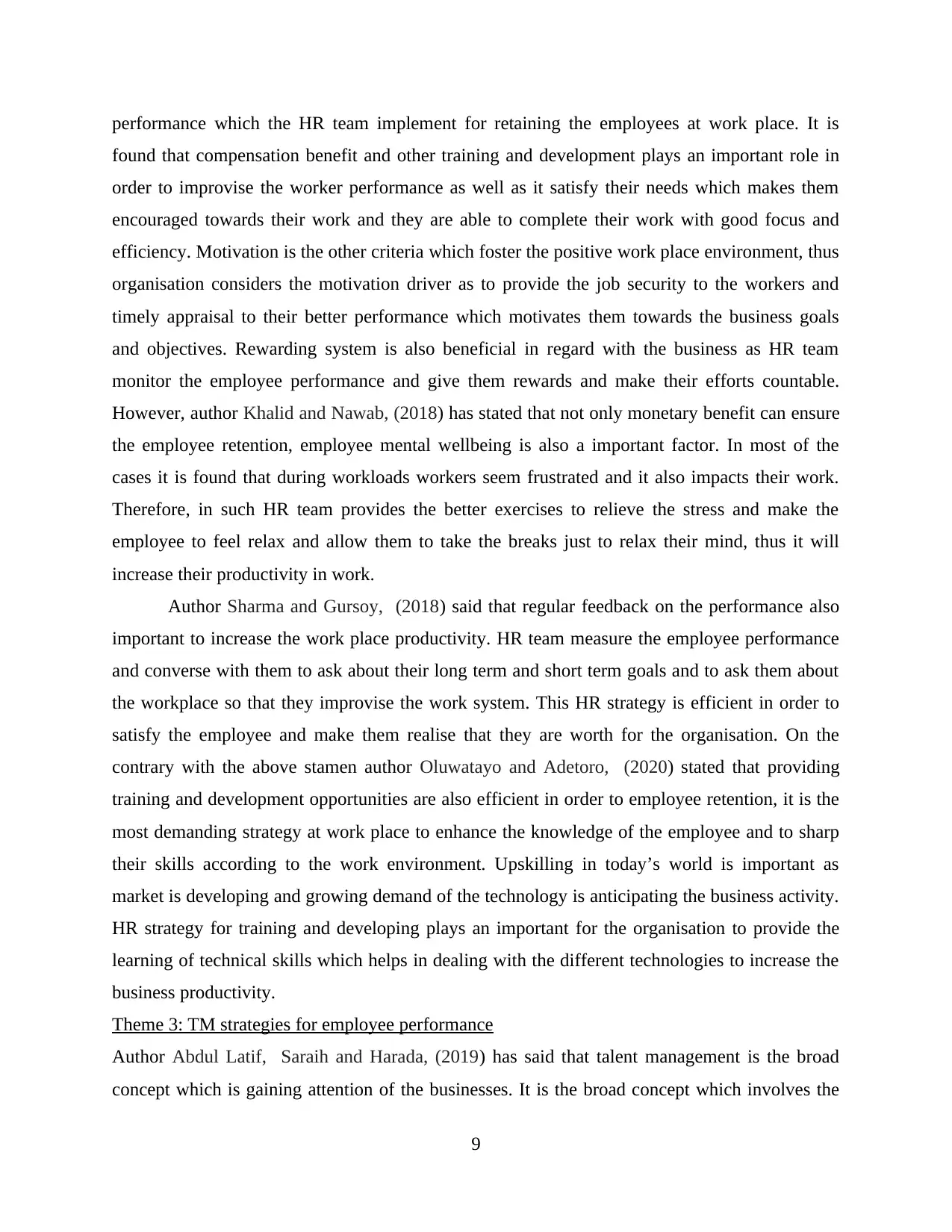
performance which the HR team implement for retaining the employees at work place. It is
found that compensation benefit and other training and development plays an important role in
order to improvise the worker performance as well as it satisfy their needs which makes them
encouraged towards their work and they are able to complete their work with good focus and
efficiency. Motivation is the other criteria which foster the positive work place environment, thus
organisation considers the motivation driver as to provide the job security to the workers and
timely appraisal to their better performance which motivates them towards the business goals
and objectives. Rewarding system is also beneficial in regard with the business as HR team
monitor the employee performance and give them rewards and make their efforts countable.
However, author Khalid and Nawab, (2018) has stated that not only monetary benefit can ensure
the employee retention, employee mental wellbeing is also a important factor. In most of the
cases it is found that during workloads workers seem frustrated and it also impacts their work.
Therefore, in such HR team provides the better exercises to relieve the stress and make the
employee to feel relax and allow them to take the breaks just to relax their mind, thus it will
increase their productivity in work.
Author Sharma and Gursoy, (2018) said that regular feedback on the performance also
important to increase the work place productivity. HR team measure the employee performance
and converse with them to ask about their long term and short term goals and to ask them about
the workplace so that they improvise the work system. This HR strategy is efficient in order to
satisfy the employee and make them realise that they are worth for the organisation. On the
contrary with the above stamen author Oluwatayo and Adetoro, (2020) stated that providing
training and development opportunities are also efficient in order to employee retention, it is the
most demanding strategy at work place to enhance the knowledge of the employee and to sharp
their skills according to the work environment. Upskilling in today’s world is important as
market is developing and growing demand of the technology is anticipating the business activity.
HR strategy for training and developing plays an important for the organisation to provide the
learning of technical skills which helps in dealing with the different technologies to increase the
business productivity.
Theme 3: TM strategies for employee performance
Author Abdul Latif, Saraih and Harada, (2019) has said that talent management is the broad
concept which is gaining attention of the businesses. It is the broad concept which involves the
9
found that compensation benefit and other training and development plays an important role in
order to improvise the worker performance as well as it satisfy their needs which makes them
encouraged towards their work and they are able to complete their work with good focus and
efficiency. Motivation is the other criteria which foster the positive work place environment, thus
organisation considers the motivation driver as to provide the job security to the workers and
timely appraisal to their better performance which motivates them towards the business goals
and objectives. Rewarding system is also beneficial in regard with the business as HR team
monitor the employee performance and give them rewards and make their efforts countable.
However, author Khalid and Nawab, (2018) has stated that not only monetary benefit can ensure
the employee retention, employee mental wellbeing is also a important factor. In most of the
cases it is found that during workloads workers seem frustrated and it also impacts their work.
Therefore, in such HR team provides the better exercises to relieve the stress and make the
employee to feel relax and allow them to take the breaks just to relax their mind, thus it will
increase their productivity in work.
Author Sharma and Gursoy, (2018) said that regular feedback on the performance also
important to increase the work place productivity. HR team measure the employee performance
and converse with them to ask about their long term and short term goals and to ask them about
the workplace so that they improvise the work system. This HR strategy is efficient in order to
satisfy the employee and make them realise that they are worth for the organisation. On the
contrary with the above stamen author Oluwatayo and Adetoro, (2020) stated that providing
training and development opportunities are also efficient in order to employee retention, it is the
most demanding strategy at work place to enhance the knowledge of the employee and to sharp
their skills according to the work environment. Upskilling in today’s world is important as
market is developing and growing demand of the technology is anticipating the business activity.
HR strategy for training and developing plays an important for the organisation to provide the
learning of technical skills which helps in dealing with the different technologies to increase the
business productivity.
Theme 3: TM strategies for employee performance
Author Abdul Latif, Saraih and Harada, (2019) has said that talent management is the broad
concept which is gaining attention of the businesses. It is the broad concept which involves the
9
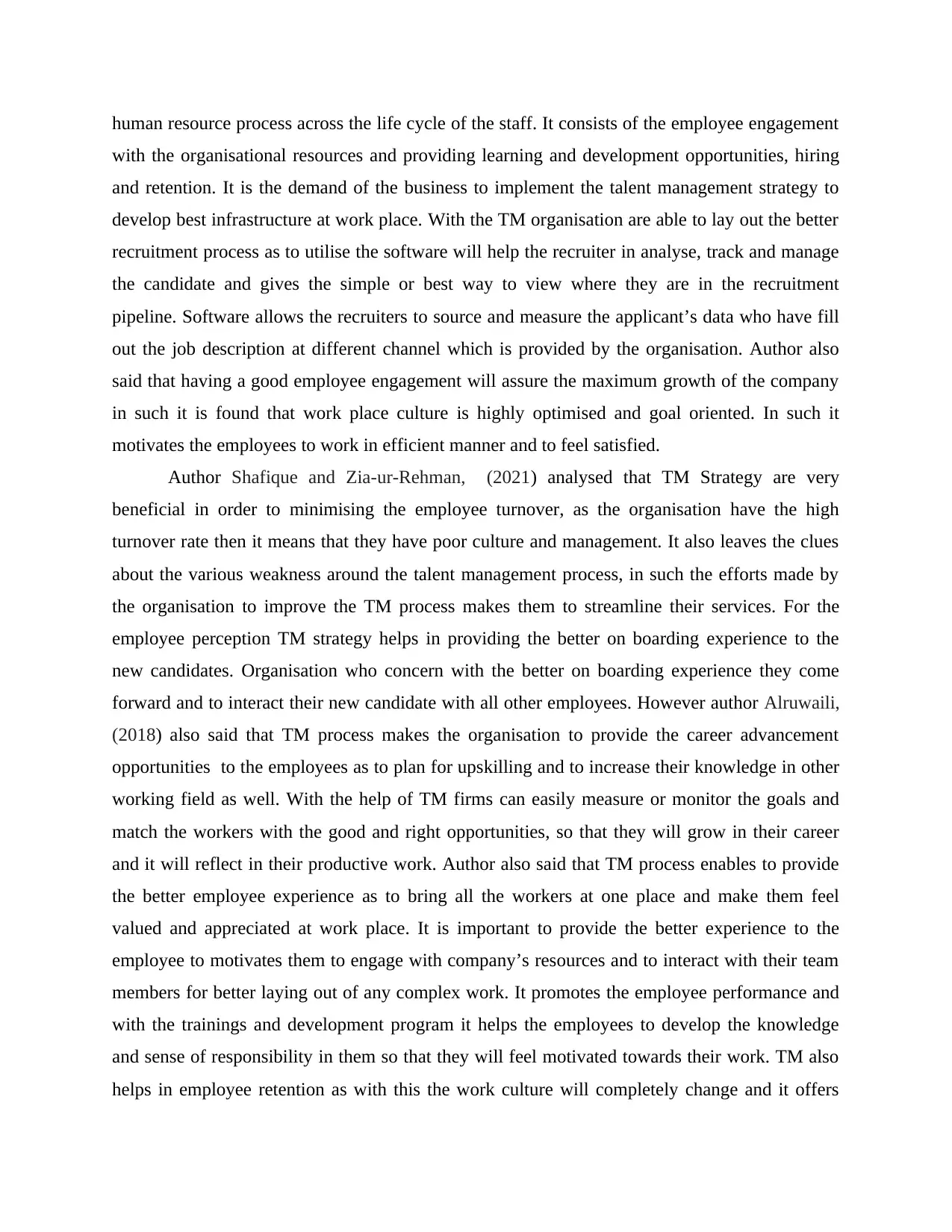
human resource process across the life cycle of the staff. It consists of the employee engagement
with the organisational resources and providing learning and development opportunities, hiring
and retention. It is the demand of the business to implement the talent management strategy to
develop best infrastructure at work place. With the TM organisation are able to lay out the better
recruitment process as to utilise the software will help the recruiter in analyse, track and manage
the candidate and gives the simple or best way to view where they are in the recruitment
pipeline. Software allows the recruiters to source and measure the applicant’s data who have fill
out the job description at different channel which is provided by the organisation. Author also
said that having a good employee engagement will assure the maximum growth of the company
in such it is found that work place culture is highly optimised and goal oriented. In such it
motivates the employees to work in efficient manner and to feel satisfied.
Author Shafique and Zia-ur-Rehman, (2021) analysed that TM Strategy are very
beneficial in order to minimising the employee turnover, as the organisation have the high
turnover rate then it means that they have poor culture and management. It also leaves the clues
about the various weakness around the talent management process, in such the efforts made by
the organisation to improve the TM process makes them to streamline their services. For the
employee perception TM strategy helps in providing the better on boarding experience to the
new candidates. Organisation who concern with the better on boarding experience they come
forward and to interact their new candidate with all other employees. However author Alruwaili,
(2018) also said that TM process makes the organisation to provide the career advancement
opportunities to the employees as to plan for upskilling and to increase their knowledge in other
working field as well. With the help of TM firms can easily measure or monitor the goals and
match the workers with the good and right opportunities, so that they will grow in their career
and it will reflect in their productive work. Author also said that TM process enables to provide
the better employee experience as to bring all the workers at one place and make them feel
valued and appreciated at work place. It is important to provide the better experience to the
employee to motivates them to engage with company’s resources and to interact with their team
members for better laying out of any complex work. It promotes the employee performance and
with the trainings and development program it helps the employees to develop the knowledge
and sense of responsibility in them so that they will feel motivated towards their work. TM also
helps in employee retention as with this the work culture will completely change and it offers
with the organisational resources and providing learning and development opportunities, hiring
and retention. It is the demand of the business to implement the talent management strategy to
develop best infrastructure at work place. With the TM organisation are able to lay out the better
recruitment process as to utilise the software will help the recruiter in analyse, track and manage
the candidate and gives the simple or best way to view where they are in the recruitment
pipeline. Software allows the recruiters to source and measure the applicant’s data who have fill
out the job description at different channel which is provided by the organisation. Author also
said that having a good employee engagement will assure the maximum growth of the company
in such it is found that work place culture is highly optimised and goal oriented. In such it
motivates the employees to work in efficient manner and to feel satisfied.
Author Shafique and Zia-ur-Rehman, (2021) analysed that TM Strategy are very
beneficial in order to minimising the employee turnover, as the organisation have the high
turnover rate then it means that they have poor culture and management. It also leaves the clues
about the various weakness around the talent management process, in such the efforts made by
the organisation to improve the TM process makes them to streamline their services. For the
employee perception TM strategy helps in providing the better on boarding experience to the
new candidates. Organisation who concern with the better on boarding experience they come
forward and to interact their new candidate with all other employees. However author Alruwaili,
(2018) also said that TM process makes the organisation to provide the career advancement
opportunities to the employees as to plan for upskilling and to increase their knowledge in other
working field as well. With the help of TM firms can easily measure or monitor the goals and
match the workers with the good and right opportunities, so that they will grow in their career
and it will reflect in their productive work. Author also said that TM process enables to provide
the better employee experience as to bring all the workers at one place and make them feel
valued and appreciated at work place. It is important to provide the better experience to the
employee to motivates them to engage with company’s resources and to interact with their team
members for better laying out of any complex work. It promotes the employee performance and
with the trainings and development program it helps the employees to develop the knowledge
and sense of responsibility in them so that they will feel motivated towards their work. TM also
helps in employee retention as with this the work culture will completely change and it offers
Secure Best Marks with AI Grader
Need help grading? Try our AI Grader for instant feedback on your assignments.
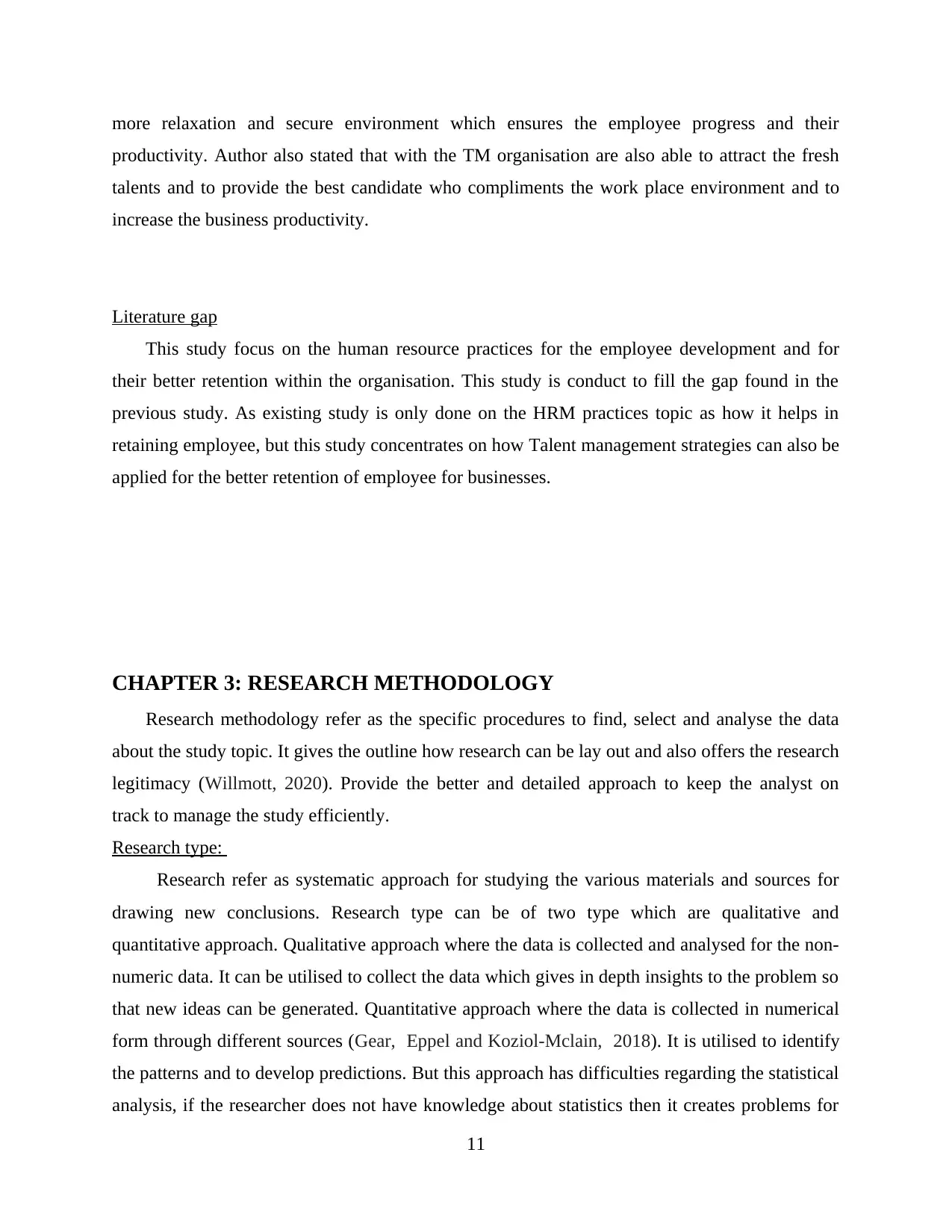
more relaxation and secure environment which ensures the employee progress and their
productivity. Author also stated that with the TM organisation are also able to attract the fresh
talents and to provide the best candidate who compliments the work place environment and to
increase the business productivity.
Literature gap
This study focus on the human resource practices for the employee development and for
their better retention within the organisation. This study is conduct to fill the gap found in the
previous study. As existing study is only done on the HRM practices topic as how it helps in
retaining employee, but this study concentrates on how Talent management strategies can also be
applied for the better retention of employee for businesses.
CHAPTER 3: RESEARCH METHODOLOGY
Research methodology refer as the specific procedures to find, select and analyse the data
about the study topic. It gives the outline how research can be lay out and also offers the research
legitimacy (Willmott, 2020). Provide the better and detailed approach to keep the analyst on
track to manage the study efficiently.
Research type:
Research refer as systematic approach for studying the various materials and sources for
drawing new conclusions. Research type can be of two type which are qualitative and
quantitative approach. Qualitative approach where the data is collected and analysed for the non-
numeric data. It can be utilised to collect the data which gives in depth insights to the problem so
that new ideas can be generated. Quantitative approach where the data is collected in numerical
form through different sources (Gear, Eppel and Koziol-Mclain, 2018). It is utilised to identify
the patterns and to develop predictions. But this approach has difficulties regarding the statistical
analysis, if the researcher does not have knowledge about statistics then it creates problems for
11
productivity. Author also stated that with the TM organisation are also able to attract the fresh
talents and to provide the best candidate who compliments the work place environment and to
increase the business productivity.
Literature gap
This study focus on the human resource practices for the employee development and for
their better retention within the organisation. This study is conduct to fill the gap found in the
previous study. As existing study is only done on the HRM practices topic as how it helps in
retaining employee, but this study concentrates on how Talent management strategies can also be
applied for the better retention of employee for businesses.
CHAPTER 3: RESEARCH METHODOLOGY
Research methodology refer as the specific procedures to find, select and analyse the data
about the study topic. It gives the outline how research can be lay out and also offers the research
legitimacy (Willmott, 2020). Provide the better and detailed approach to keep the analyst on
track to manage the study efficiently.
Research type:
Research refer as systematic approach for studying the various materials and sources for
drawing new conclusions. Research type can be of two type which are qualitative and
quantitative approach. Qualitative approach where the data is collected and analysed for the non-
numeric data. It can be utilised to collect the data which gives in depth insights to the problem so
that new ideas can be generated. Quantitative approach where the data is collected in numerical
form through different sources (Gear, Eppel and Koziol-Mclain, 2018). It is utilised to identify
the patterns and to develop predictions. But this approach has difficulties regarding the statistical
analysis, if the researcher does not have knowledge about statistics then it creates problems for
11
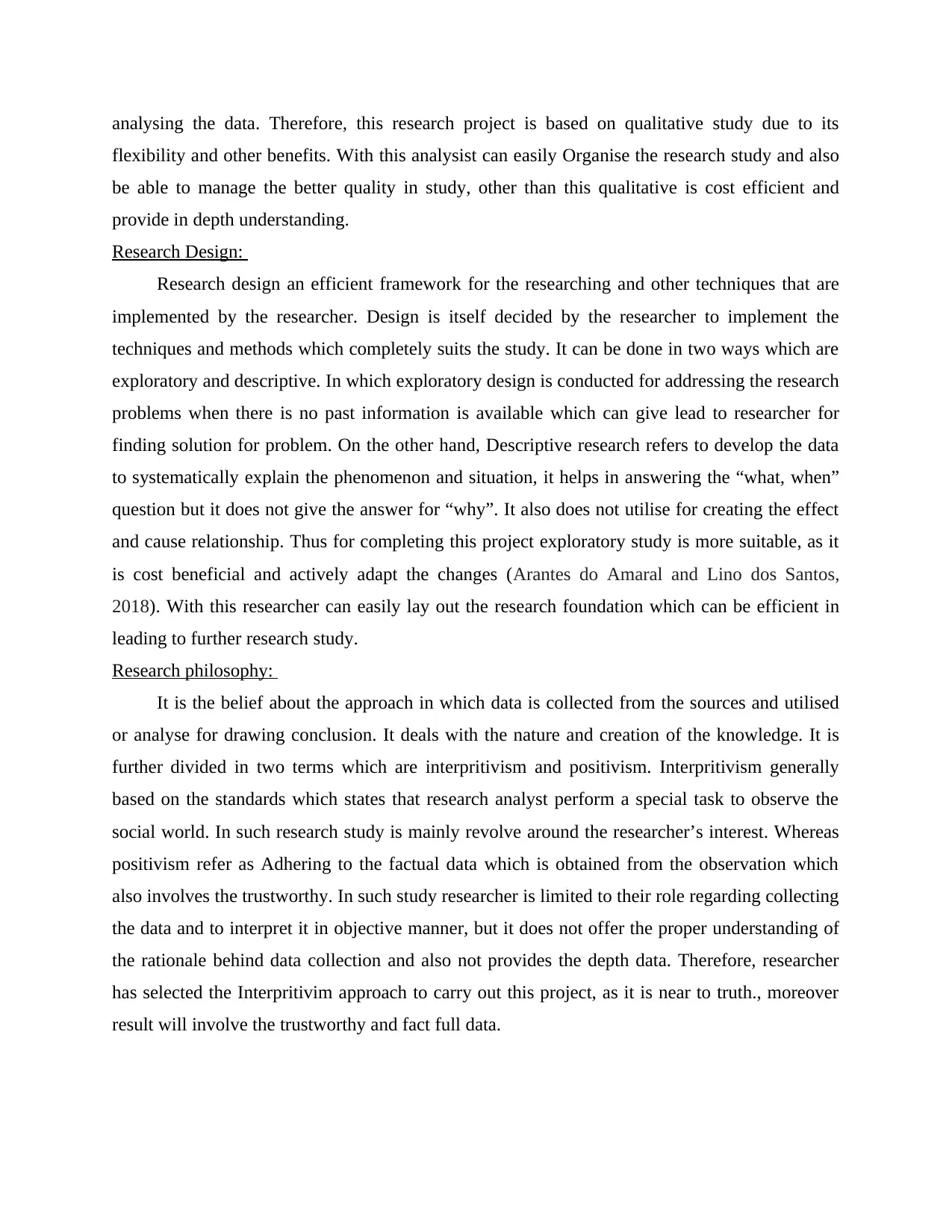
analysing the data. Therefore, this research project is based on qualitative study due to its
flexibility and other benefits. With this analysist can easily Organise the research study and also
be able to manage the better quality in study, other than this qualitative is cost efficient and
provide in depth understanding.
Research Design:
Research design an efficient framework for the researching and other techniques that are
implemented by the researcher. Design is itself decided by the researcher to implement the
techniques and methods which completely suits the study. It can be done in two ways which are
exploratory and descriptive. In which exploratory design is conducted for addressing the research
problems when there is no past information is available which can give lead to researcher for
finding solution for problem. On the other hand, Descriptive research refers to develop the data
to systematically explain the phenomenon and situation, it helps in answering the “what, when”
question but it does not give the answer for “why”. It also does not utilise for creating the effect
and cause relationship. Thus for completing this project exploratory study is more suitable, as it
is cost beneficial and actively adapt the changes (Arantes do Amaral and Lino dos Santos,
2018). With this researcher can easily lay out the research foundation which can be efficient in
leading to further research study.
Research philosophy:
It is the belief about the approach in which data is collected from the sources and utilised
or analyse for drawing conclusion. It deals with the nature and creation of the knowledge. It is
further divided in two terms which are interpritivism and positivism. Interpritivism generally
based on the standards which states that research analyst perform a special task to observe the
social world. In such research study is mainly revolve around the researcher’s interest. Whereas
positivism refer as Adhering to the factual data which is obtained from the observation which
also involves the trustworthy. In such study researcher is limited to their role regarding collecting
the data and to interpret it in objective manner, but it does not offer the proper understanding of
the rationale behind data collection and also not provides the depth data. Therefore, researcher
has selected the Interpritivim approach to carry out this project, as it is near to truth., moreover
result will involve the trustworthy and fact full data.
flexibility and other benefits. With this analysist can easily Organise the research study and also
be able to manage the better quality in study, other than this qualitative is cost efficient and
provide in depth understanding.
Research Design:
Research design an efficient framework for the researching and other techniques that are
implemented by the researcher. Design is itself decided by the researcher to implement the
techniques and methods which completely suits the study. It can be done in two ways which are
exploratory and descriptive. In which exploratory design is conducted for addressing the research
problems when there is no past information is available which can give lead to researcher for
finding solution for problem. On the other hand, Descriptive research refers to develop the data
to systematically explain the phenomenon and situation, it helps in answering the “what, when”
question but it does not give the answer for “why”. It also does not utilise for creating the effect
and cause relationship. Thus for completing this project exploratory study is more suitable, as it
is cost beneficial and actively adapt the changes (Arantes do Amaral and Lino dos Santos,
2018). With this researcher can easily lay out the research foundation which can be efficient in
leading to further research study.
Research philosophy:
It is the belief about the approach in which data is collected from the sources and utilised
or analyse for drawing conclusion. It deals with the nature and creation of the knowledge. It is
further divided in two terms which are interpritivism and positivism. Interpritivism generally
based on the standards which states that research analyst perform a special task to observe the
social world. In such research study is mainly revolve around the researcher’s interest. Whereas
positivism refer as Adhering to the factual data which is obtained from the observation which
also involves the trustworthy. In such study researcher is limited to their role regarding collecting
the data and to interpret it in objective manner, but it does not offer the proper understanding of
the rationale behind data collection and also not provides the depth data. Therefore, researcher
has selected the Interpritivim approach to carry out this project, as it is near to truth., moreover
result will involve the trustworthy and fact full data.
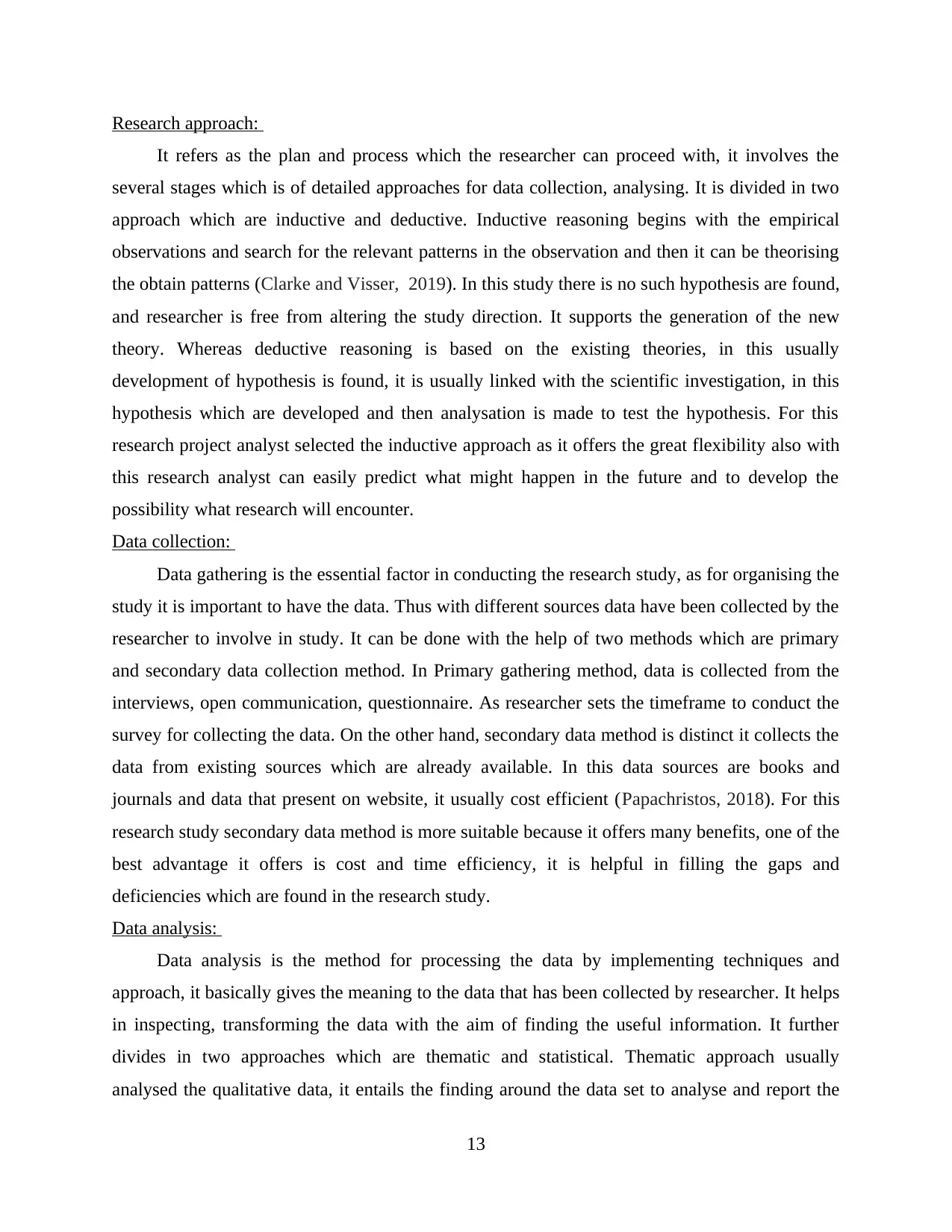
Research approach:
It refers as the plan and process which the researcher can proceed with, it involves the
several stages which is of detailed approaches for data collection, analysing. It is divided in two
approach which are inductive and deductive. Inductive reasoning begins with the empirical
observations and search for the relevant patterns in the observation and then it can be theorising
the obtain patterns (Clarke and Visser, 2019). In this study there is no such hypothesis are found,
and researcher is free from altering the study direction. It supports the generation of the new
theory. Whereas deductive reasoning is based on the existing theories, in this usually
development of hypothesis is found, it is usually linked with the scientific investigation, in this
hypothesis which are developed and then analysation is made to test the hypothesis. For this
research project analyst selected the inductive approach as it offers the great flexibility also with
this research analyst can easily predict what might happen in the future and to develop the
possibility what research will encounter.
Data collection:
Data gathering is the essential factor in conducting the research study, as for organising the
study it is important to have the data. Thus with different sources data have been collected by the
researcher to involve in study. It can be done with the help of two methods which are primary
and secondary data collection method. In Primary gathering method, data is collected from the
interviews, open communication, questionnaire. As researcher sets the timeframe to conduct the
survey for collecting the data. On the other hand, secondary data method is distinct it collects the
data from existing sources which are already available. In this data sources are books and
journals and data that present on website, it usually cost efficient (Papachristos, 2018). For this
research study secondary data method is more suitable because it offers many benefits, one of the
best advantage it offers is cost and time efficiency, it is helpful in filling the gaps and
deficiencies which are found in the research study.
Data analysis:
Data analysis is the method for processing the data by implementing techniques and
approach, it basically gives the meaning to the data that has been collected by researcher. It helps
in inspecting, transforming the data with the aim of finding the useful information. It further
divides in two approaches which are thematic and statistical. Thematic approach usually
analysed the qualitative data, it entails the finding around the data set to analyse and report the
13
It refers as the plan and process which the researcher can proceed with, it involves the
several stages which is of detailed approaches for data collection, analysing. It is divided in two
approach which are inductive and deductive. Inductive reasoning begins with the empirical
observations and search for the relevant patterns in the observation and then it can be theorising
the obtain patterns (Clarke and Visser, 2019). In this study there is no such hypothesis are found,
and researcher is free from altering the study direction. It supports the generation of the new
theory. Whereas deductive reasoning is based on the existing theories, in this usually
development of hypothesis is found, it is usually linked with the scientific investigation, in this
hypothesis which are developed and then analysation is made to test the hypothesis. For this
research project analyst selected the inductive approach as it offers the great flexibility also with
this research analyst can easily predict what might happen in the future and to develop the
possibility what research will encounter.
Data collection:
Data gathering is the essential factor in conducting the research study, as for organising the
study it is important to have the data. Thus with different sources data have been collected by the
researcher to involve in study. It can be done with the help of two methods which are primary
and secondary data collection method. In Primary gathering method, data is collected from the
interviews, open communication, questionnaire. As researcher sets the timeframe to conduct the
survey for collecting the data. On the other hand, secondary data method is distinct it collects the
data from existing sources which are already available. In this data sources are books and
journals and data that present on website, it usually cost efficient (Papachristos, 2018). For this
research study secondary data method is more suitable because it offers many benefits, one of the
best advantage it offers is cost and time efficiency, it is helpful in filling the gaps and
deficiencies which are found in the research study.
Data analysis:
Data analysis is the method for processing the data by implementing techniques and
approach, it basically gives the meaning to the data that has been collected by researcher. It helps
in inspecting, transforming the data with the aim of finding the useful information. It further
divides in two approaches which are thematic and statistical. Thematic approach usually
analysed the qualitative data, it entails the finding around the data set to analyse and report the
13
Paraphrase This Document
Need a fresh take? Get an instant paraphrase of this document with our AI Paraphraser
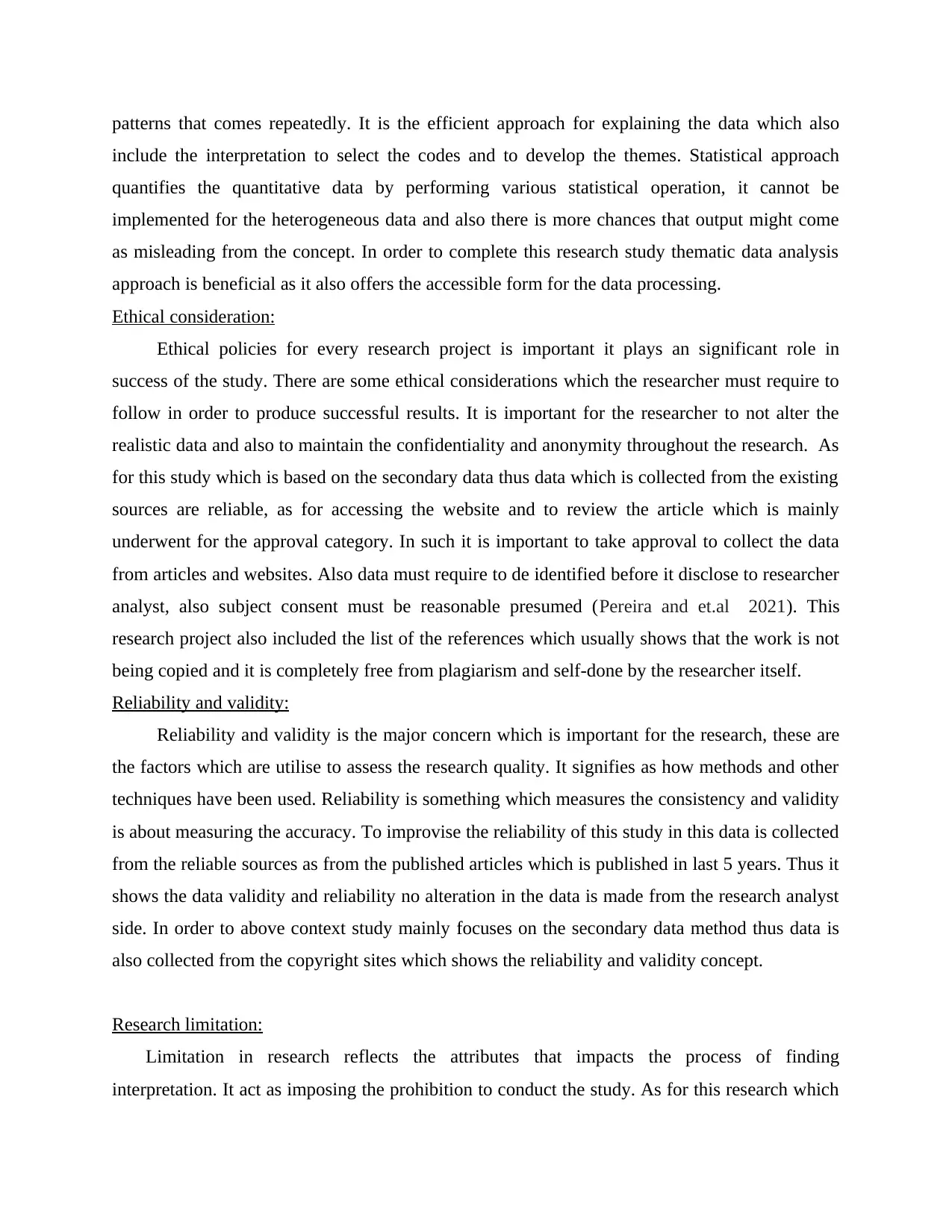
patterns that comes repeatedly. It is the efficient approach for explaining the data which also
include the interpretation to select the codes and to develop the themes. Statistical approach
quantifies the quantitative data by performing various statistical operation, it cannot be
implemented for the heterogeneous data and also there is more chances that output might come
as misleading from the concept. In order to complete this research study thematic data analysis
approach is beneficial as it also offers the accessible form for the data processing.
Ethical consideration:
Ethical policies for every research project is important it plays an significant role in
success of the study. There are some ethical considerations which the researcher must require to
follow in order to produce successful results. It is important for the researcher to not alter the
realistic data and also to maintain the confidentiality and anonymity throughout the research. As
for this study which is based on the secondary data thus data which is collected from the existing
sources are reliable, as for accessing the website and to review the article which is mainly
underwent for the approval category. In such it is important to take approval to collect the data
from articles and websites. Also data must require to de identified before it disclose to researcher
analyst, also subject consent must be reasonable presumed (Pereira and et.al 2021). This
research project also included the list of the references which usually shows that the work is not
being copied and it is completely free from plagiarism and self-done by the researcher itself.
Reliability and validity:
Reliability and validity is the major concern which is important for the research, these are
the factors which are utilise to assess the research quality. It signifies as how methods and other
techniques have been used. Reliability is something which measures the consistency and validity
is about measuring the accuracy. To improvise the reliability of this study in this data is collected
from the reliable sources as from the published articles which is published in last 5 years. Thus it
shows the data validity and reliability no alteration in the data is made from the research analyst
side. In order to above context study mainly focuses on the secondary data method thus data is
also collected from the copyright sites which shows the reliability and validity concept.
Research limitation:
Limitation in research reflects the attributes that impacts the process of finding
interpretation. It act as imposing the prohibition to conduct the study. As for this research which
include the interpretation to select the codes and to develop the themes. Statistical approach
quantifies the quantitative data by performing various statistical operation, it cannot be
implemented for the heterogeneous data and also there is more chances that output might come
as misleading from the concept. In order to complete this research study thematic data analysis
approach is beneficial as it also offers the accessible form for the data processing.
Ethical consideration:
Ethical policies for every research project is important it plays an significant role in
success of the study. There are some ethical considerations which the researcher must require to
follow in order to produce successful results. It is important for the researcher to not alter the
realistic data and also to maintain the confidentiality and anonymity throughout the research. As
for this study which is based on the secondary data thus data which is collected from the existing
sources are reliable, as for accessing the website and to review the article which is mainly
underwent for the approval category. In such it is important to take approval to collect the data
from articles and websites. Also data must require to de identified before it disclose to researcher
analyst, also subject consent must be reasonable presumed (Pereira and et.al 2021). This
research project also included the list of the references which usually shows that the work is not
being copied and it is completely free from plagiarism and self-done by the researcher itself.
Reliability and validity:
Reliability and validity is the major concern which is important for the research, these are
the factors which are utilise to assess the research quality. It signifies as how methods and other
techniques have been used. Reliability is something which measures the consistency and validity
is about measuring the accuracy. To improvise the reliability of this study in this data is collected
from the reliable sources as from the published articles which is published in last 5 years. Thus it
shows the data validity and reliability no alteration in the data is made from the research analyst
side. In order to above context study mainly focuses on the secondary data method thus data is
also collected from the copyright sites which shows the reliability and validity concept.
Research limitation:
Limitation in research reflects the attributes that impacts the process of finding
interpretation. It act as imposing the prohibition to conduct the study. As for this research which
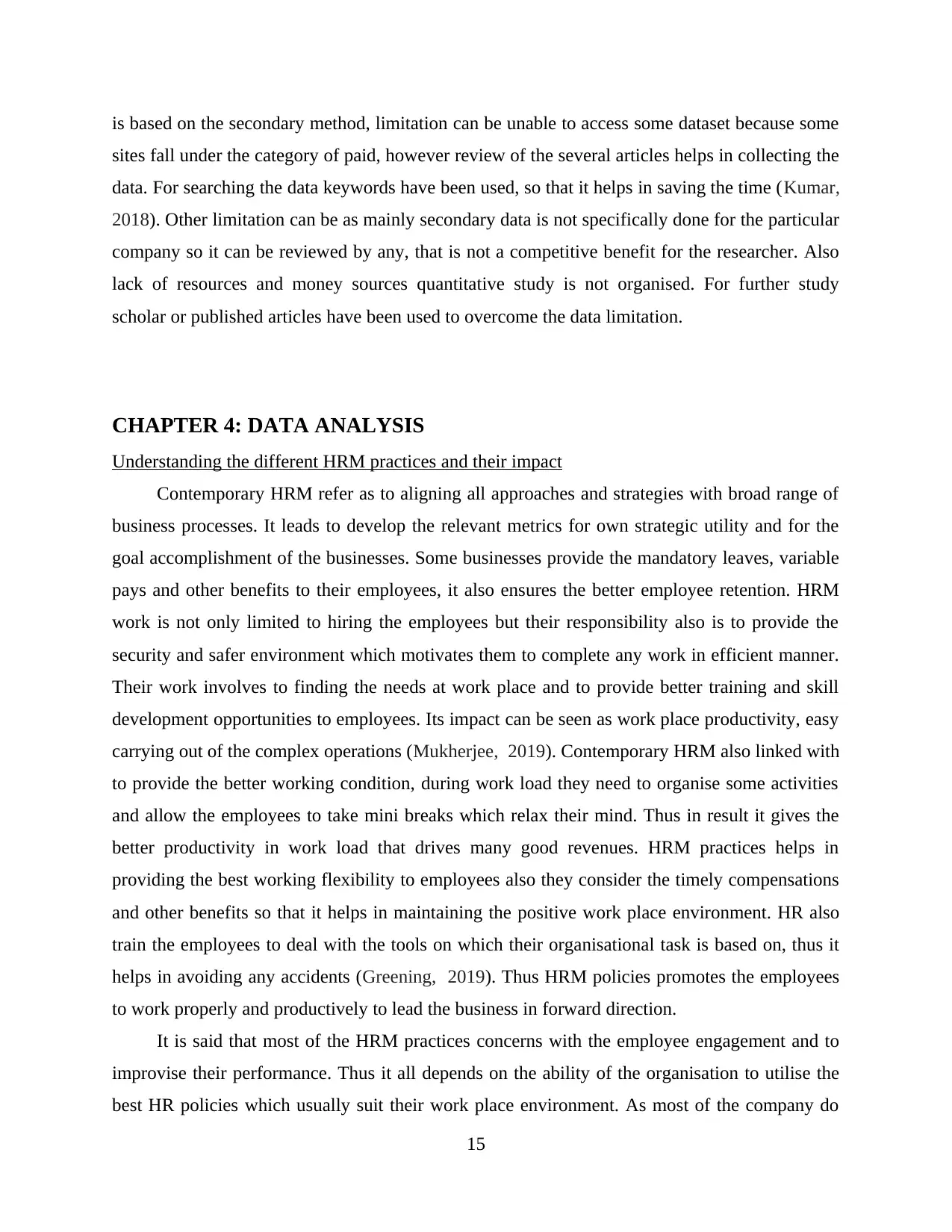
is based on the secondary method, limitation can be unable to access some dataset because some
sites fall under the category of paid, however review of the several articles helps in collecting the
data. For searching the data keywords have been used, so that it helps in saving the time (Kumar,
2018). Other limitation can be as mainly secondary data is not specifically done for the particular
company so it can be reviewed by any, that is not a competitive benefit for the researcher. Also
lack of resources and money sources quantitative study is not organised. For further study
scholar or published articles have been used to overcome the data limitation.
CHAPTER 4: DATA ANALYSIS
Understanding the different HRM practices and their impact
Contemporary HRM refer as to aligning all approaches and strategies with broad range of
business processes. It leads to develop the relevant metrics for own strategic utility and for the
goal accomplishment of the businesses. Some businesses provide the mandatory leaves, variable
pays and other benefits to their employees, it also ensures the better employee retention. HRM
work is not only limited to hiring the employees but their responsibility also is to provide the
security and safer environment which motivates them to complete any work in efficient manner.
Their work involves to finding the needs at work place and to provide better training and skill
development opportunities to employees. Its impact can be seen as work place productivity, easy
carrying out of the complex operations (Mukherjee, 2019). Contemporary HRM also linked with
to provide the better working condition, during work load they need to organise some activities
and allow the employees to take mini breaks which relax their mind. Thus in result it gives the
better productivity in work load that drives many good revenues. HRM practices helps in
providing the best working flexibility to employees also they consider the timely compensations
and other benefits so that it helps in maintaining the positive work place environment. HR also
train the employees to deal with the tools on which their organisational task is based on, thus it
helps in avoiding any accidents (Greening, 2019). Thus HRM policies promotes the employees
to work properly and productively to lead the business in forward direction.
It is said that most of the HRM practices concerns with the employee engagement and to
improvise their performance. Thus it all depends on the ability of the organisation to utilise the
best HR policies which usually suit their work place environment. As most of the company do
15
sites fall under the category of paid, however review of the several articles helps in collecting the
data. For searching the data keywords have been used, so that it helps in saving the time (Kumar,
2018). Other limitation can be as mainly secondary data is not specifically done for the particular
company so it can be reviewed by any, that is not a competitive benefit for the researcher. Also
lack of resources and money sources quantitative study is not organised. For further study
scholar or published articles have been used to overcome the data limitation.
CHAPTER 4: DATA ANALYSIS
Understanding the different HRM practices and their impact
Contemporary HRM refer as to aligning all approaches and strategies with broad range of
business processes. It leads to develop the relevant metrics for own strategic utility and for the
goal accomplishment of the businesses. Some businesses provide the mandatory leaves, variable
pays and other benefits to their employees, it also ensures the better employee retention. HRM
work is not only limited to hiring the employees but their responsibility also is to provide the
security and safer environment which motivates them to complete any work in efficient manner.
Their work involves to finding the needs at work place and to provide better training and skill
development opportunities to employees. Its impact can be seen as work place productivity, easy
carrying out of the complex operations (Mukherjee, 2019). Contemporary HRM also linked with
to provide the better working condition, during work load they need to organise some activities
and allow the employees to take mini breaks which relax their mind. Thus in result it gives the
better productivity in work load that drives many good revenues. HRM practices helps in
providing the best working flexibility to employees also they consider the timely compensations
and other benefits so that it helps in maintaining the positive work place environment. HR also
train the employees to deal with the tools on which their organisational task is based on, thus it
helps in avoiding any accidents (Greening, 2019). Thus HRM policies promotes the employees
to work properly and productively to lead the business in forward direction.
It is said that most of the HRM practices concerns with the employee engagement and to
improvise their performance. Thus it all depends on the ability of the organisation to utilise the
best HR policies which usually suit their work place environment. As most of the company do
15
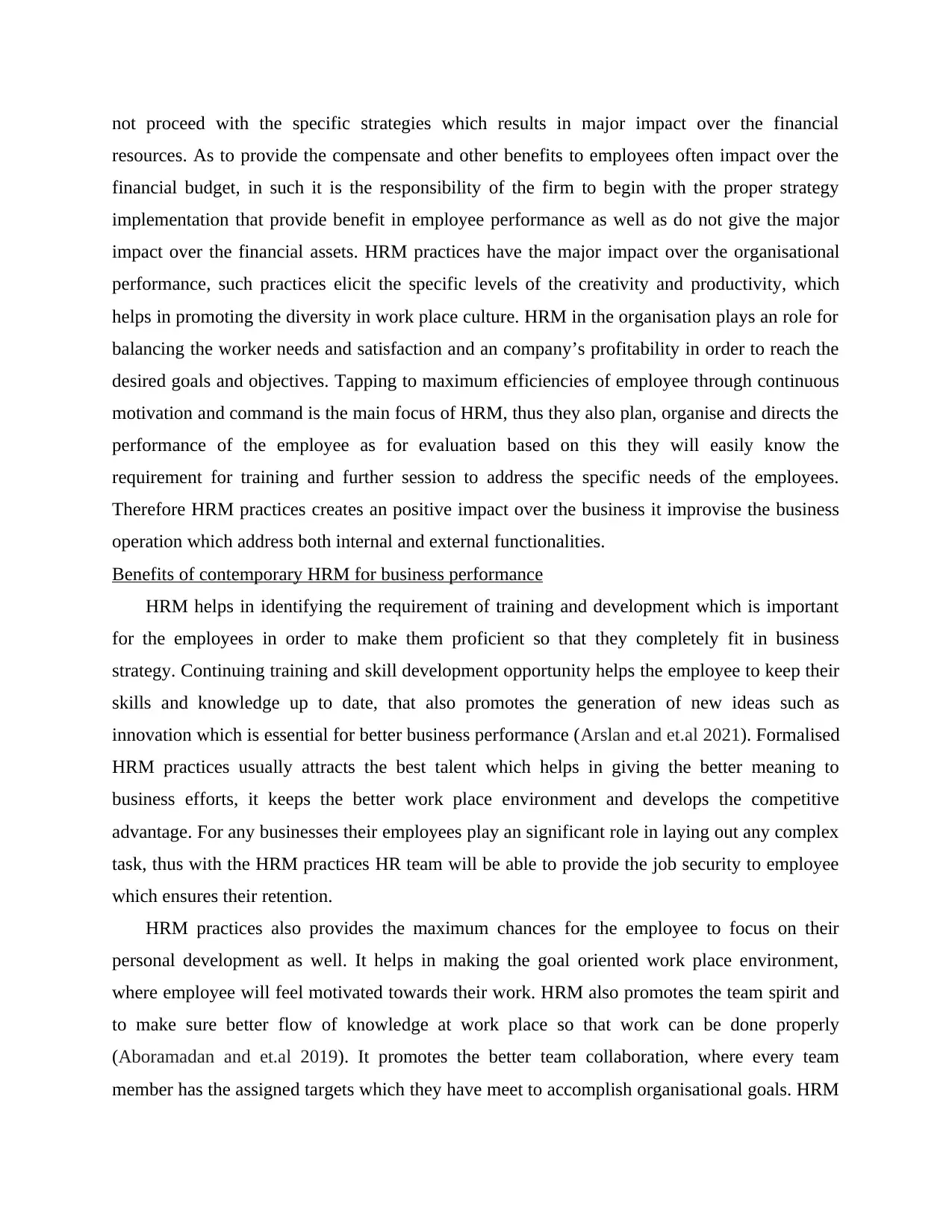
not proceed with the specific strategies which results in major impact over the financial
resources. As to provide the compensate and other benefits to employees often impact over the
financial budget, in such it is the responsibility of the firm to begin with the proper strategy
implementation that provide benefit in employee performance as well as do not give the major
impact over the financial assets. HRM practices have the major impact over the organisational
performance, such practices elicit the specific levels of the creativity and productivity, which
helps in promoting the diversity in work place culture. HRM in the organisation plays an role for
balancing the worker needs and satisfaction and an company’s profitability in order to reach the
desired goals and objectives. Tapping to maximum efficiencies of employee through continuous
motivation and command is the main focus of HRM, thus they also plan, organise and directs the
performance of the employee as for evaluation based on this they will easily know the
requirement for training and further session to address the specific needs of the employees.
Therefore HRM practices creates an positive impact over the business it improvise the business
operation which address both internal and external functionalities.
Benefits of contemporary HRM for business performance
HRM helps in identifying the requirement of training and development which is important
for the employees in order to make them proficient so that they completely fit in business
strategy. Continuing training and skill development opportunity helps the employee to keep their
skills and knowledge up to date, that also promotes the generation of new ideas such as
innovation which is essential for better business performance (Arslan and et.al 2021). Formalised
HRM practices usually attracts the best talent which helps in giving the better meaning to
business efforts, it keeps the better work place environment and develops the competitive
advantage. For any businesses their employees play an significant role in laying out any complex
task, thus with the HRM practices HR team will be able to provide the job security to employee
which ensures their retention.
HRM practices also provides the maximum chances for the employee to focus on their
personal development as well. It helps in making the goal oriented work place environment,
where employee will feel motivated towards their work. HRM also promotes the team spirit and
to make sure better flow of knowledge at work place so that work can be done properly
(Aboramadan and et.al 2019). It promotes the better team collaboration, where every team
member has the assigned targets which they have meet to accomplish organisational goals. HRM
resources. As to provide the compensate and other benefits to employees often impact over the
financial budget, in such it is the responsibility of the firm to begin with the proper strategy
implementation that provide benefit in employee performance as well as do not give the major
impact over the financial assets. HRM practices have the major impact over the organisational
performance, such practices elicit the specific levels of the creativity and productivity, which
helps in promoting the diversity in work place culture. HRM in the organisation plays an role for
balancing the worker needs and satisfaction and an company’s profitability in order to reach the
desired goals and objectives. Tapping to maximum efficiencies of employee through continuous
motivation and command is the main focus of HRM, thus they also plan, organise and directs the
performance of the employee as for evaluation based on this they will easily know the
requirement for training and further session to address the specific needs of the employees.
Therefore HRM practices creates an positive impact over the business it improvise the business
operation which address both internal and external functionalities.
Benefits of contemporary HRM for business performance
HRM helps in identifying the requirement of training and development which is important
for the employees in order to make them proficient so that they completely fit in business
strategy. Continuing training and skill development opportunity helps the employee to keep their
skills and knowledge up to date, that also promotes the generation of new ideas such as
innovation which is essential for better business performance (Arslan and et.al 2021). Formalised
HRM practices usually attracts the best talent which helps in giving the better meaning to
business efforts, it keeps the better work place environment and develops the competitive
advantage. For any businesses their employees play an significant role in laying out any complex
task, thus with the HRM practices HR team will be able to provide the job security to employee
which ensures their retention.
HRM practices also provides the maximum chances for the employee to focus on their
personal development as well. It helps in making the goal oriented work place environment,
where employee will feel motivated towards their work. HRM also promotes the team spirit and
to make sure better flow of knowledge at work place so that work can be done properly
(Aboramadan and et.al 2019). It promotes the better team collaboration, where every team
member has the assigned targets which they have meet to accomplish organisational goals. HRM
Secure Best Marks with AI Grader
Need help grading? Try our AI Grader for instant feedback on your assignments.
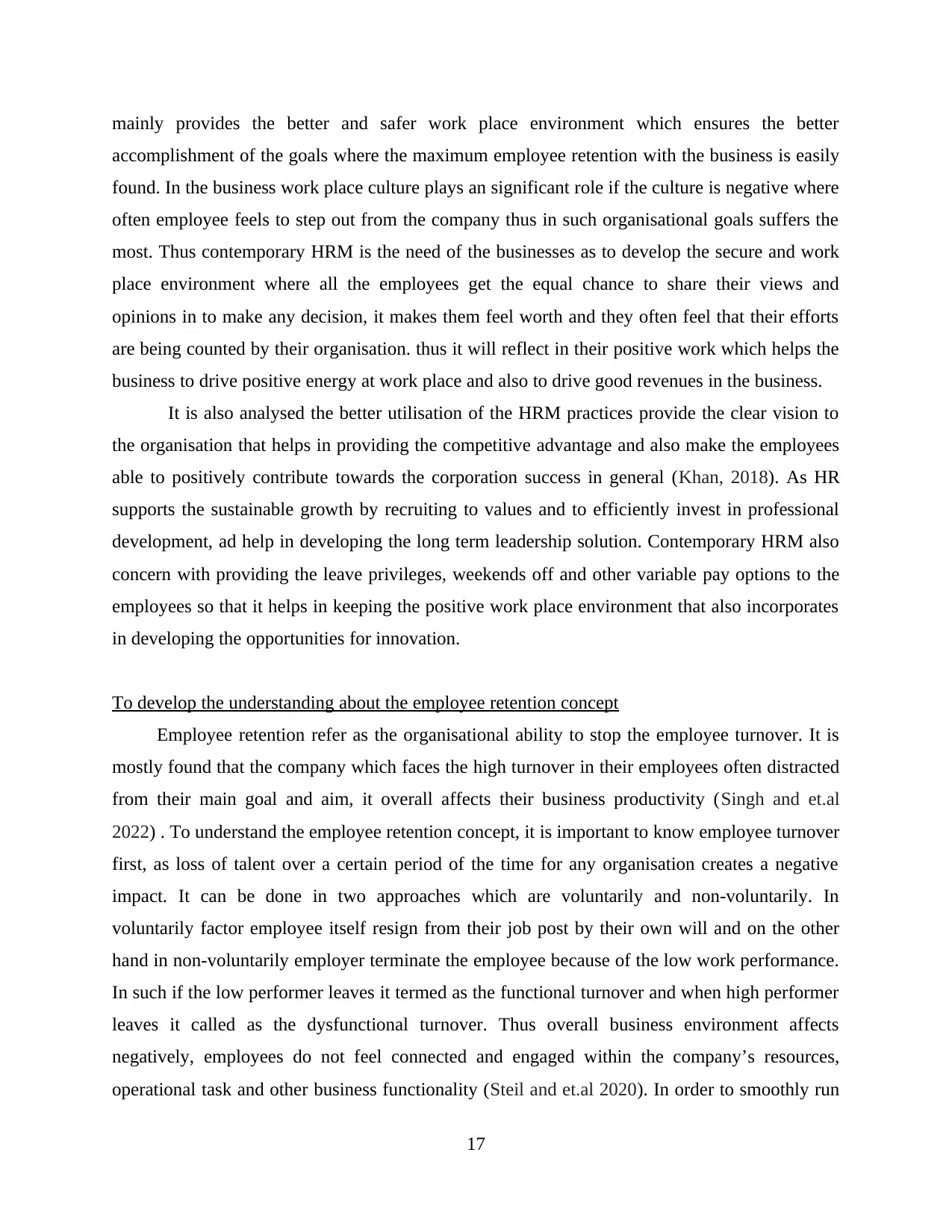
mainly provides the better and safer work place environment which ensures the better
accomplishment of the goals where the maximum employee retention with the business is easily
found. In the business work place culture plays an significant role if the culture is negative where
often employee feels to step out from the company thus in such organisational goals suffers the
most. Thus contemporary HRM is the need of the businesses as to develop the secure and work
place environment where all the employees get the equal chance to share their views and
opinions in to make any decision, it makes them feel worth and they often feel that their efforts
are being counted by their organisation. thus it will reflect in their positive work which helps the
business to drive positive energy at work place and also to drive good revenues in the business.
It is also analysed the better utilisation of the HRM practices provide the clear vision to
the organisation that helps in providing the competitive advantage and also make the employees
able to positively contribute towards the corporation success in general (Khan, 2018). As HR
supports the sustainable growth by recruiting to values and to efficiently invest in professional
development, ad help in developing the long term leadership solution. Contemporary HRM also
concern with providing the leave privileges, weekends off and other variable pay options to the
employees so that it helps in keeping the positive work place environment that also incorporates
in developing the opportunities for innovation.
To develop the understanding about the employee retention concept
Employee retention refer as the organisational ability to stop the employee turnover. It is
mostly found that the company which faces the high turnover in their employees often distracted
from their main goal and aim, it overall affects their business productivity (Singh and et.al
2022) . To understand the employee retention concept, it is important to know employee turnover
first, as loss of talent over a certain period of the time for any organisation creates a negative
impact. It can be done in two approaches which are voluntarily and non-voluntarily. In
voluntarily factor employee itself resign from their job post by their own will and on the other
hand in non-voluntarily employer terminate the employee because of the low work performance.
In such if the low performer leaves it termed as the functional turnover and when high performer
leaves it called as the dysfunctional turnover. Thus overall business environment affects
negatively, employees do not feel connected and engaged within the company’s resources,
operational task and other business functionality (Steil and et.al 2020). In order to smoothly run
17
accomplishment of the goals where the maximum employee retention with the business is easily
found. In the business work place culture plays an significant role if the culture is negative where
often employee feels to step out from the company thus in such organisational goals suffers the
most. Thus contemporary HRM is the need of the businesses as to develop the secure and work
place environment where all the employees get the equal chance to share their views and
opinions in to make any decision, it makes them feel worth and they often feel that their efforts
are being counted by their organisation. thus it will reflect in their positive work which helps the
business to drive positive energy at work place and also to drive good revenues in the business.
It is also analysed the better utilisation of the HRM practices provide the clear vision to
the organisation that helps in providing the competitive advantage and also make the employees
able to positively contribute towards the corporation success in general (Khan, 2018). As HR
supports the sustainable growth by recruiting to values and to efficiently invest in professional
development, ad help in developing the long term leadership solution. Contemporary HRM also
concern with providing the leave privileges, weekends off and other variable pay options to the
employees so that it helps in keeping the positive work place environment that also incorporates
in developing the opportunities for innovation.
To develop the understanding about the employee retention concept
Employee retention refer as the organisational ability to stop the employee turnover. It is
mostly found that the company which faces the high turnover in their employees often distracted
from their main goal and aim, it overall affects their business productivity (Singh and et.al
2022) . To understand the employee retention concept, it is important to know employee turnover
first, as loss of talent over a certain period of the time for any organisation creates a negative
impact. It can be done in two approaches which are voluntarily and non-voluntarily. In
voluntarily factor employee itself resign from their job post by their own will and on the other
hand in non-voluntarily employer terminate the employee because of the low work performance.
In such if the low performer leaves it termed as the functional turnover and when high performer
leaves it called as the dysfunctional turnover. Thus overall business environment affects
negatively, employees do not feel connected and engaged within the company’s resources,
operational task and other business functionality (Steil and et.al 2020). In order to smoothly run
17

the business, it is foremost to have the better work force which makes every move possible to
generate revenues. Therefore, employee retention for any organisation plays a significant role. It
is further proposed that having higher rate in employee retention will make the organisation to
acquire the greater share in the market, as well as it makes them able to efficiently compete and
make their goals and objectives achievable.
It is also found that there are other factor as well which can be the reason for the employee
turnover which can be negative work place culture and also biasness from higher authority
forced the person to leave the firm premises and search for other job opportunities. However, it
can be also said that best management and HR practices helps in employee retention as to
provide the best working conditions that ensures the maximum employee engagement with
organisational resources. employee retention benefited the organisation in many aspects such as
it enhances the profitability rate as well as help in managing the both internal as well as external
aspect of the business (Bibi, Ahmad and Majid, 2018). Companies mainly invest on their
recruitment process it cost more thus if they have the better policies for the employees which
makes them satisfied, in such there is no need for continually organise the recruitment program
which consumes money as well as time resources. additionally, it can be said that if longer the
worker connected to the firm it gives as result in more enhanced engagement and in knowledge,
thus it helps the organisation to solve their any problem within a time frame so that they can
make their desired objectives and goals achievable. Experienced employees also able to provide
the better customer experience that is must for every business as long as customer is satisfied
businesses will be able to keep their better performance.
Understanding the HR practices in terms of employee retention
Contemporary HRM is the main demand for every organisation, as it makes them able to
streamline all their business functionalities for better return of revenues. HRM team mainly focus
on to minimising the risk of employee turnover as it gives the adverse or bad impact over the
company’s performance (Gan and Yusof, 2019). Specifically, HRM practices concern with the
training and development, compensation benefits and other monetary as well as non-monetary
benefit which aims to improvise the employee and organisational relationship so employee feel
motivated and responsible towards business goals, it often reflects in their better and productive
work. However, it is also identified that some HR management only believes in providing the
monetary benefit they only feel that employee is working for the sake of their own, it is
generate revenues. Therefore, employee retention for any organisation plays a significant role. It
is further proposed that having higher rate in employee retention will make the organisation to
acquire the greater share in the market, as well as it makes them able to efficiently compete and
make their goals and objectives achievable.
It is also found that there are other factor as well which can be the reason for the employee
turnover which can be negative work place culture and also biasness from higher authority
forced the person to leave the firm premises and search for other job opportunities. However, it
can be also said that best management and HR practices helps in employee retention as to
provide the best working conditions that ensures the maximum employee engagement with
organisational resources. employee retention benefited the organisation in many aspects such as
it enhances the profitability rate as well as help in managing the both internal as well as external
aspect of the business (Bibi, Ahmad and Majid, 2018). Companies mainly invest on their
recruitment process it cost more thus if they have the better policies for the employees which
makes them satisfied, in such there is no need for continually organise the recruitment program
which consumes money as well as time resources. additionally, it can be said that if longer the
worker connected to the firm it gives as result in more enhanced engagement and in knowledge,
thus it helps the organisation to solve their any problem within a time frame so that they can
make their desired objectives and goals achievable. Experienced employees also able to provide
the better customer experience that is must for every business as long as customer is satisfied
businesses will be able to keep their better performance.
Understanding the HR practices in terms of employee retention
Contemporary HRM is the main demand for every organisation, as it makes them able to
streamline all their business functionalities for better return of revenues. HRM team mainly focus
on to minimising the risk of employee turnover as it gives the adverse or bad impact over the
company’s performance (Gan and Yusof, 2019). Specifically, HRM practices concern with the
training and development, compensation benefits and other monetary as well as non-monetary
benefit which aims to improvise the employee and organisational relationship so employee feel
motivated and responsible towards business goals, it often reflects in their better and productive
work. However, it is also identified that some HR management only believes in providing the
monetary benefit they only feel that employee is working for the sake of their own, it is
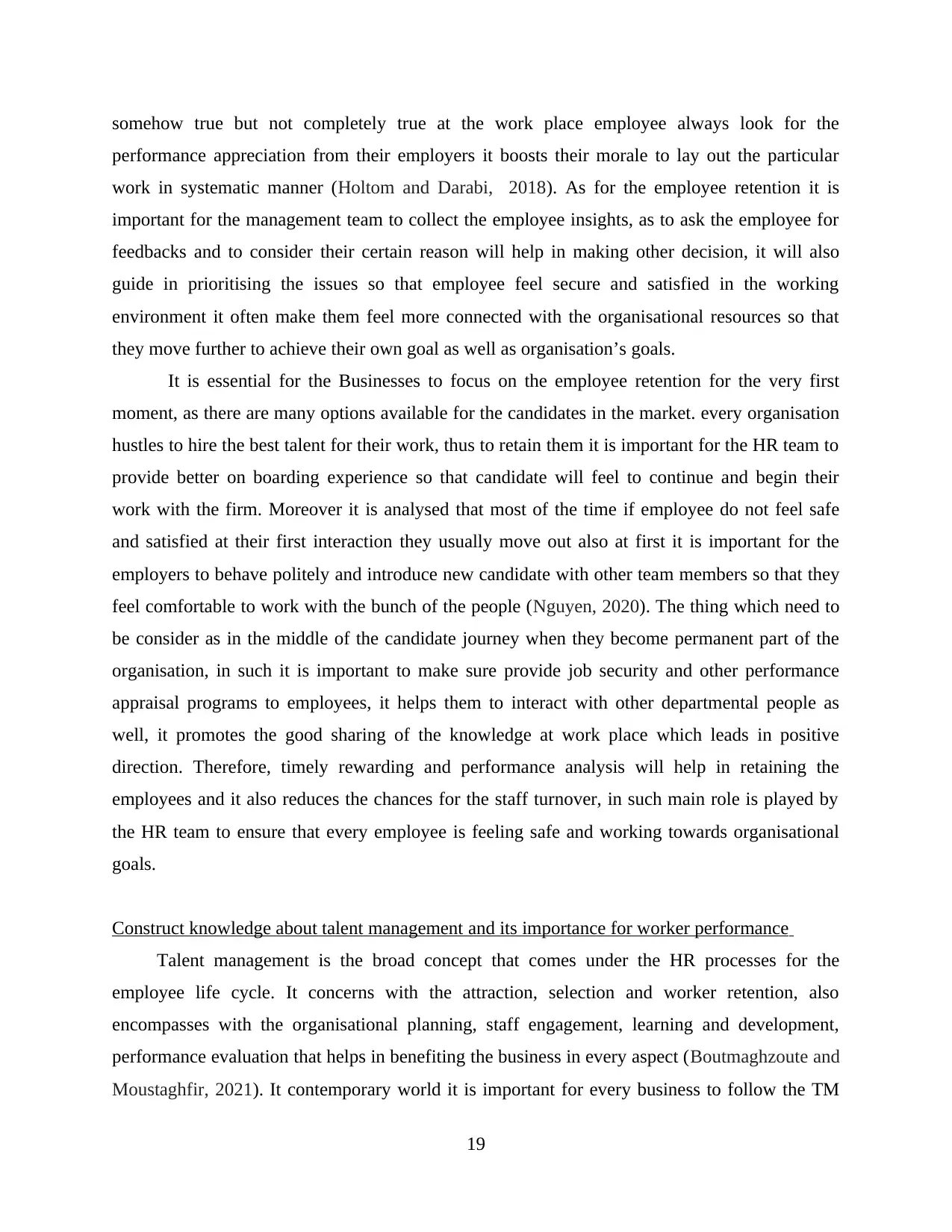
somehow true but not completely true at the work place employee always look for the
performance appreciation from their employers it boosts their morale to lay out the particular
work in systematic manner (Holtom and Darabi, 2018). As for the employee retention it is
important for the management team to collect the employee insights, as to ask the employee for
feedbacks and to consider their certain reason will help in making other decision, it will also
guide in prioritising the issues so that employee feel secure and satisfied in the working
environment it often make them feel more connected with the organisational resources so that
they move further to achieve their own goal as well as organisation’s goals.
It is essential for the Businesses to focus on the employee retention for the very first
moment, as there are many options available for the candidates in the market. every organisation
hustles to hire the best talent for their work, thus to retain them it is important for the HR team to
provide better on boarding experience so that candidate will feel to continue and begin their
work with the firm. Moreover it is analysed that most of the time if employee do not feel safe
and satisfied at their first interaction they usually move out also at first it is important for the
employers to behave politely and introduce new candidate with other team members so that they
feel comfortable to work with the bunch of the people (Nguyen, 2020). The thing which need to
be consider as in the middle of the candidate journey when they become permanent part of the
organisation, in such it is important to make sure provide job security and other performance
appraisal programs to employees, it helps them to interact with other departmental people as
well, it promotes the good sharing of the knowledge at work place which leads in positive
direction. Therefore, timely rewarding and performance analysis will help in retaining the
employees and it also reduces the chances for the staff turnover, in such main role is played by
the HR team to ensure that every employee is feeling safe and working towards organisational
goals.
Construct knowledge about talent management and its importance for worker performance
Talent management is the broad concept that comes under the HR processes for the
employee life cycle. It concerns with the attraction, selection and worker retention, also
encompasses with the organisational planning, staff engagement, learning and development,
performance evaluation that helps in benefiting the business in every aspect (Boutmaghzoute and
Moustaghfir, 2021). It contemporary world it is important for every business to follow the TM
19
performance appreciation from their employers it boosts their morale to lay out the particular
work in systematic manner (Holtom and Darabi, 2018). As for the employee retention it is
important for the management team to collect the employee insights, as to ask the employee for
feedbacks and to consider their certain reason will help in making other decision, it will also
guide in prioritising the issues so that employee feel secure and satisfied in the working
environment it often make them feel more connected with the organisational resources so that
they move further to achieve their own goal as well as organisation’s goals.
It is essential for the Businesses to focus on the employee retention for the very first
moment, as there are many options available for the candidates in the market. every organisation
hustles to hire the best talent for their work, thus to retain them it is important for the HR team to
provide better on boarding experience so that candidate will feel to continue and begin their
work with the firm. Moreover it is analysed that most of the time if employee do not feel safe
and satisfied at their first interaction they usually move out also at first it is important for the
employers to behave politely and introduce new candidate with other team members so that they
feel comfortable to work with the bunch of the people (Nguyen, 2020). The thing which need to
be consider as in the middle of the candidate journey when they become permanent part of the
organisation, in such it is important to make sure provide job security and other performance
appraisal programs to employees, it helps them to interact with other departmental people as
well, it promotes the good sharing of the knowledge at work place which leads in positive
direction. Therefore, timely rewarding and performance analysis will help in retaining the
employees and it also reduces the chances for the staff turnover, in such main role is played by
the HR team to ensure that every employee is feeling safe and working towards organisational
goals.
Construct knowledge about talent management and its importance for worker performance
Talent management is the broad concept that comes under the HR processes for the
employee life cycle. It concerns with the attraction, selection and worker retention, also
encompasses with the organisational planning, staff engagement, learning and development,
performance evaluation that helps in benefiting the business in every aspect (Boutmaghzoute and
Moustaghfir, 2021). It contemporary world it is important for every business to follow the TM
19
Paraphrase This Document
Need a fresh take? Get an instant paraphrase of this document with our AI Paraphraser
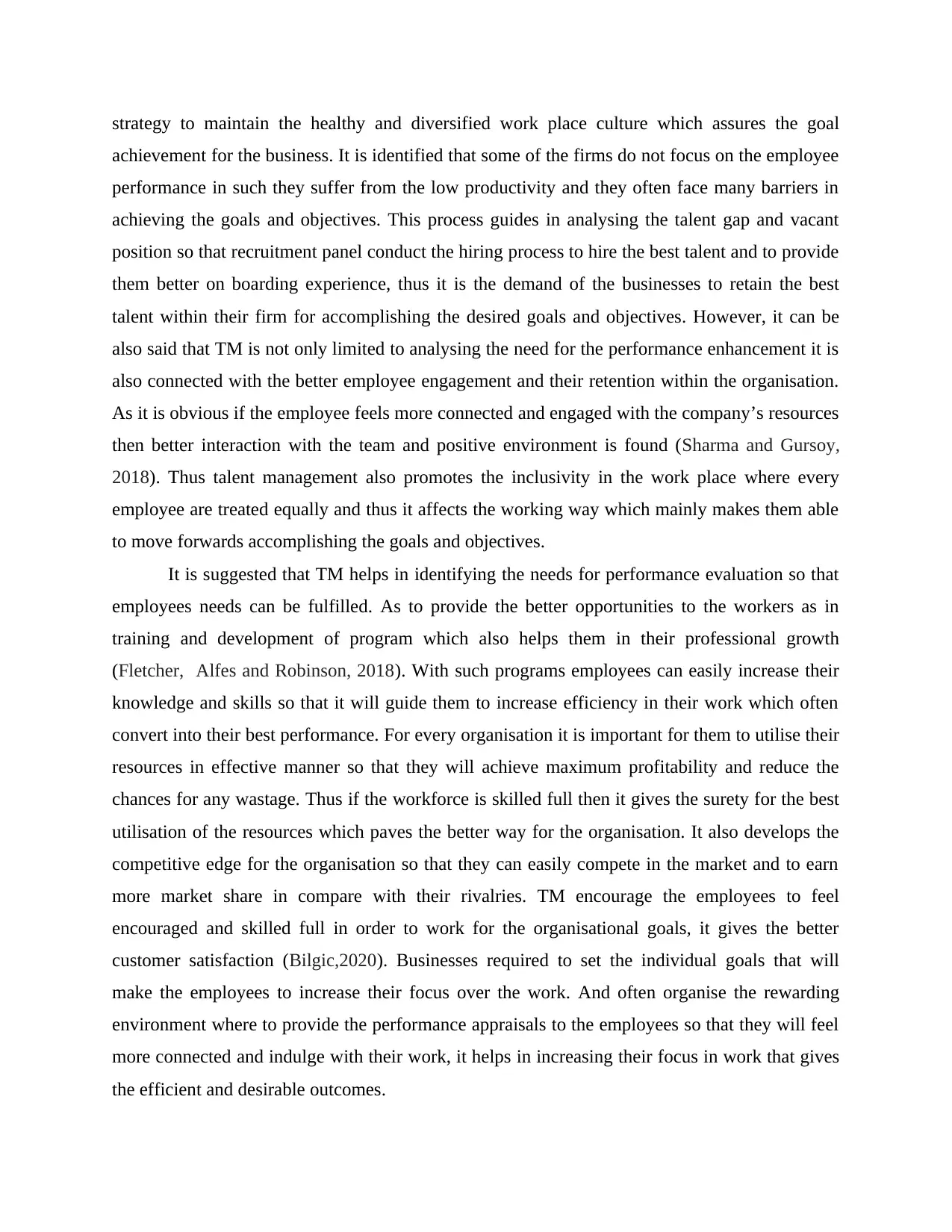
strategy to maintain the healthy and diversified work place culture which assures the goal
achievement for the business. It is identified that some of the firms do not focus on the employee
performance in such they suffer from the low productivity and they often face many barriers in
achieving the goals and objectives. This process guides in analysing the talent gap and vacant
position so that recruitment panel conduct the hiring process to hire the best talent and to provide
them better on boarding experience, thus it is the demand of the businesses to retain the best
talent within their firm for accomplishing the desired goals and objectives. However, it can be
also said that TM is not only limited to analysing the need for the performance enhancement it is
also connected with the better employee engagement and their retention within the organisation.
As it is obvious if the employee feels more connected and engaged with the company’s resources
then better interaction with the team and positive environment is found (Sharma and Gursoy,
2018). Thus talent management also promotes the inclusivity in the work place where every
employee are treated equally and thus it affects the working way which mainly makes them able
to move forwards accomplishing the goals and objectives.
It is suggested that TM helps in identifying the needs for performance evaluation so that
employees needs can be fulfilled. As to provide the better opportunities to the workers as in
training and development of program which also helps them in their professional growth
(Fletcher, Alfes and Robinson, 2018). With such programs employees can easily increase their
knowledge and skills so that it will guide them to increase efficiency in their work which often
convert into their best performance. For every organisation it is important for them to utilise their
resources in effective manner so that they will achieve maximum profitability and reduce the
chances for any wastage. Thus if the workforce is skilled full then it gives the surety for the best
utilisation of the resources which paves the better way for the organisation. It also develops the
competitive edge for the organisation so that they can easily compete in the market and to earn
more market share in compare with their rivalries. TM encourage the employees to feel
encouraged and skilled full in order to work for the organisational goals, it gives the better
customer satisfaction (Bilgic,2020). Businesses required to set the individual goals that will
make the employees to increase their focus over the work. And often organise the rewarding
environment where to provide the performance appraisals to the employees so that they will feel
more connected and indulge with their work, it helps in increasing their focus in work that gives
the efficient and desirable outcomes.
achievement for the business. It is identified that some of the firms do not focus on the employee
performance in such they suffer from the low productivity and they often face many barriers in
achieving the goals and objectives. This process guides in analysing the talent gap and vacant
position so that recruitment panel conduct the hiring process to hire the best talent and to provide
them better on boarding experience, thus it is the demand of the businesses to retain the best
talent within their firm for accomplishing the desired goals and objectives. However, it can be
also said that TM is not only limited to analysing the need for the performance enhancement it is
also connected with the better employee engagement and their retention within the organisation.
As it is obvious if the employee feels more connected and engaged with the company’s resources
then better interaction with the team and positive environment is found (Sharma and Gursoy,
2018). Thus talent management also promotes the inclusivity in the work place where every
employee are treated equally and thus it affects the working way which mainly makes them able
to move forwards accomplishing the goals and objectives.
It is suggested that TM helps in identifying the needs for performance evaluation so that
employees needs can be fulfilled. As to provide the better opportunities to the workers as in
training and development of program which also helps them in their professional growth
(Fletcher, Alfes and Robinson, 2018). With such programs employees can easily increase their
knowledge and skills so that it will guide them to increase efficiency in their work which often
convert into their best performance. For every organisation it is important for them to utilise their
resources in effective manner so that they will achieve maximum profitability and reduce the
chances for any wastage. Thus if the workforce is skilled full then it gives the surety for the best
utilisation of the resources which paves the better way for the organisation. It also develops the
competitive edge for the organisation so that they can easily compete in the market and to earn
more market share in compare with their rivalries. TM encourage the employees to feel
encouraged and skilled full in order to work for the organisational goals, it gives the better
customer satisfaction (Bilgic,2020). Businesses required to set the individual goals that will
make the employees to increase their focus over the work. And often organise the rewarding
environment where to provide the performance appraisals to the employees so that they will feel
more connected and indulge with their work, it helps in increasing their focus in work that gives
the efficient and desirable outcomes.
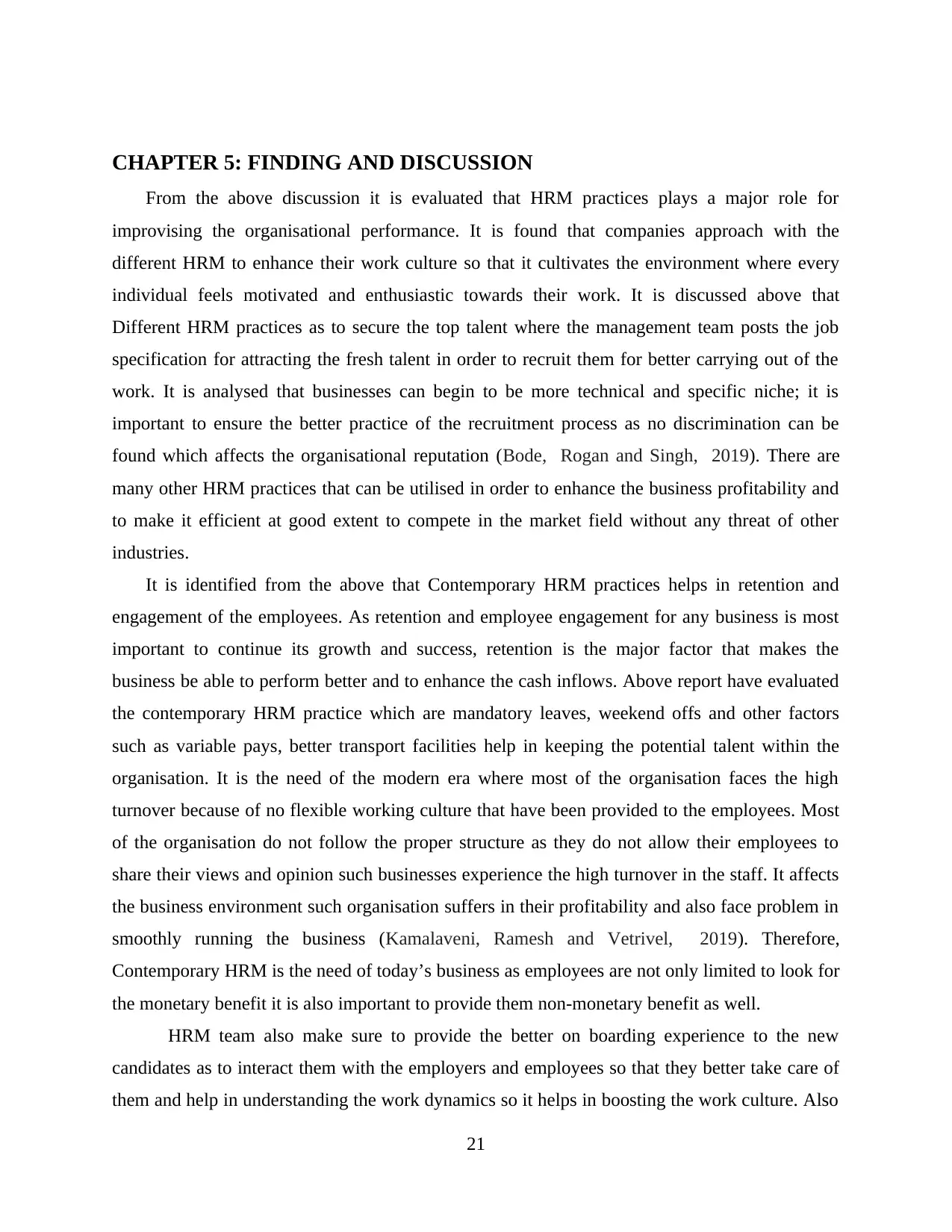
CHAPTER 5: FINDING AND DISCUSSION
From the above discussion it is evaluated that HRM practices plays a major role for
improvising the organisational performance. It is found that companies approach with the
different HRM to enhance their work culture so that it cultivates the environment where every
individual feels motivated and enthusiastic towards their work. It is discussed above that
Different HRM practices as to secure the top talent where the management team posts the job
specification for attracting the fresh talent in order to recruit them for better carrying out of the
work. It is analysed that businesses can begin to be more technical and specific niche; it is
important to ensure the better practice of the recruitment process as no discrimination can be
found which affects the organisational reputation (Bode, Rogan and Singh, 2019). There are
many other HRM practices that can be utilised in order to enhance the business profitability and
to make it efficient at good extent to compete in the market field without any threat of other
industries.
It is identified from the above that Contemporary HRM practices helps in retention and
engagement of the employees. As retention and employee engagement for any business is most
important to continue its growth and success, retention is the major factor that makes the
business be able to perform better and to enhance the cash inflows. Above report have evaluated
the contemporary HRM practice which are mandatory leaves, weekend offs and other factors
such as variable pays, better transport facilities help in keeping the potential talent within the
organisation. It is the need of the modern era where most of the organisation faces the high
turnover because of no flexible working culture that have been provided to the employees. Most
of the organisation do not follow the proper structure as they do not allow their employees to
share their views and opinion such businesses experience the high turnover in the staff. It affects
the business environment such organisation suffers in their profitability and also face problem in
smoothly running the business (Kamalaveni, Ramesh and Vetrivel, 2019). Therefore,
Contemporary HRM is the need of today’s business as employees are not only limited to look for
the monetary benefit it is also important to provide them non-monetary benefit as well.
HRM team also make sure to provide the better on boarding experience to the new
candidates as to interact them with the employers and employees so that they better take care of
them and help in understanding the work dynamics so it helps in boosting the work culture. Also
21
From the above discussion it is evaluated that HRM practices plays a major role for
improvising the organisational performance. It is found that companies approach with the
different HRM to enhance their work culture so that it cultivates the environment where every
individual feels motivated and enthusiastic towards their work. It is discussed above that
Different HRM practices as to secure the top talent where the management team posts the job
specification for attracting the fresh talent in order to recruit them for better carrying out of the
work. It is analysed that businesses can begin to be more technical and specific niche; it is
important to ensure the better practice of the recruitment process as no discrimination can be
found which affects the organisational reputation (Bode, Rogan and Singh, 2019). There are
many other HRM practices that can be utilised in order to enhance the business profitability and
to make it efficient at good extent to compete in the market field without any threat of other
industries.
It is identified from the above that Contemporary HRM practices helps in retention and
engagement of the employees. As retention and employee engagement for any business is most
important to continue its growth and success, retention is the major factor that makes the
business be able to perform better and to enhance the cash inflows. Above report have evaluated
the contemporary HRM practice which are mandatory leaves, weekend offs and other factors
such as variable pays, better transport facilities help in keeping the potential talent within the
organisation. It is the need of the modern era where most of the organisation faces the high
turnover because of no flexible working culture that have been provided to the employees. Most
of the organisation do not follow the proper structure as they do not allow their employees to
share their views and opinion such businesses experience the high turnover in the staff. It affects
the business environment such organisation suffers in their profitability and also face problem in
smoothly running the business (Kamalaveni, Ramesh and Vetrivel, 2019). Therefore,
Contemporary HRM is the need of today’s business as employees are not only limited to look for
the monetary benefit it is also important to provide them non-monetary benefit as well.
HRM team also make sure to provide the better on boarding experience to the new
candidates as to interact them with the employers and employees so that they better take care of
them and help in understanding the work dynamics so it helps in boosting the work culture. Also
21
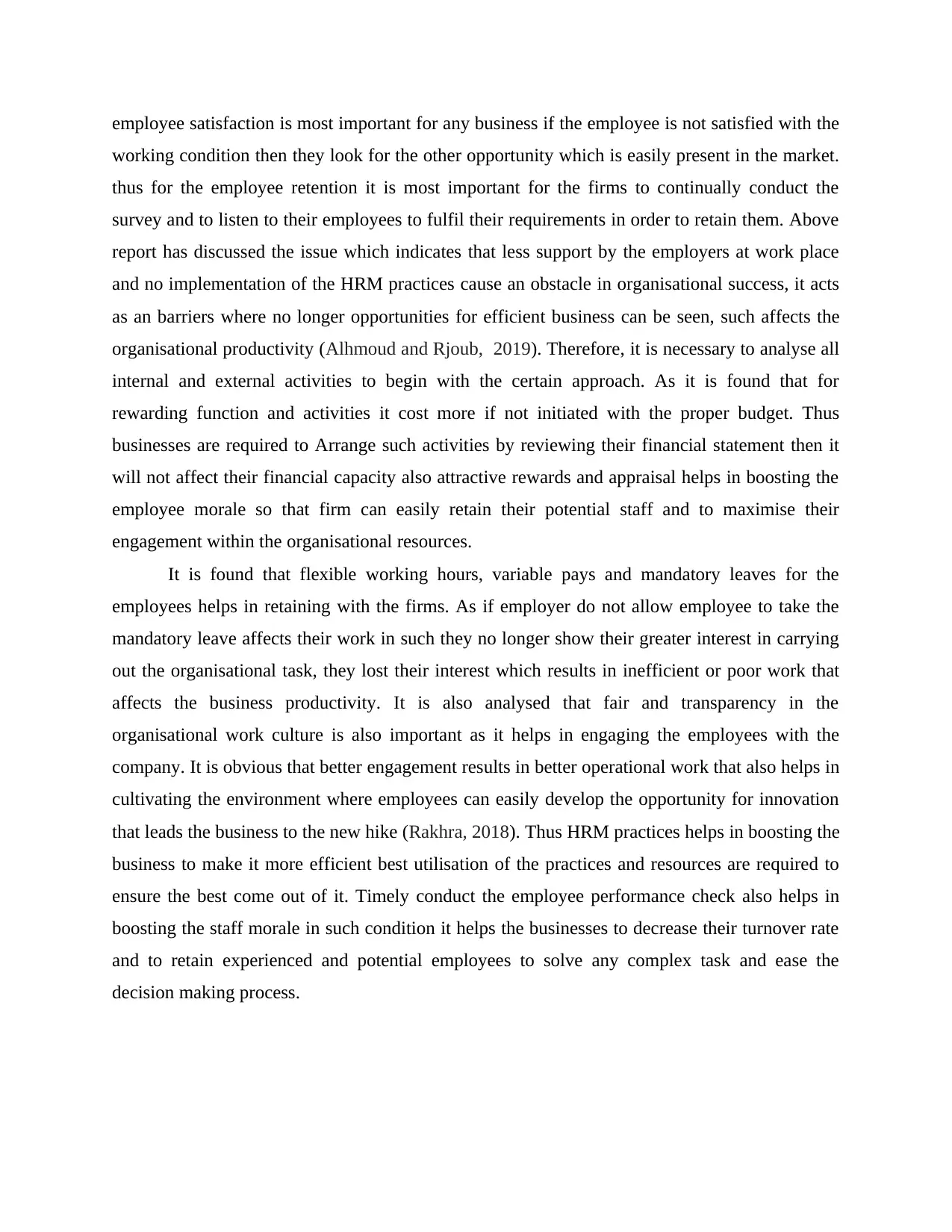
employee satisfaction is most important for any business if the employee is not satisfied with the
working condition then they look for the other opportunity which is easily present in the market.
thus for the employee retention it is most important for the firms to continually conduct the
survey and to listen to their employees to fulfil their requirements in order to retain them. Above
report has discussed the issue which indicates that less support by the employers at work place
and no implementation of the HRM practices cause an obstacle in organisational success, it acts
as an barriers where no longer opportunities for efficient business can be seen, such affects the
organisational productivity (Alhmoud and Rjoub, 2019). Therefore, it is necessary to analyse all
internal and external activities to begin with the certain approach. As it is found that for
rewarding function and activities it cost more if not initiated with the proper budget. Thus
businesses are required to Arrange such activities by reviewing their financial statement then it
will not affect their financial capacity also attractive rewards and appraisal helps in boosting the
employee morale so that firm can easily retain their potential staff and to maximise their
engagement within the organisational resources.
It is found that flexible working hours, variable pays and mandatory leaves for the
employees helps in retaining with the firms. As if employer do not allow employee to take the
mandatory leave affects their work in such they no longer show their greater interest in carrying
out the organisational task, they lost their interest which results in inefficient or poor work that
affects the business productivity. It is also analysed that fair and transparency in the
organisational work culture is also important as it helps in engaging the employees with the
company. It is obvious that better engagement results in better operational work that also helps in
cultivating the environment where employees can easily develop the opportunity for innovation
that leads the business to the new hike (Rakhra, 2018). Thus HRM practices helps in boosting the
business to make it more efficient best utilisation of the practices and resources are required to
ensure the best come out of it. Timely conduct the employee performance check also helps in
boosting the staff morale in such condition it helps the businesses to decrease their turnover rate
and to retain experienced and potential employees to solve any complex task and ease the
decision making process.
working condition then they look for the other opportunity which is easily present in the market.
thus for the employee retention it is most important for the firms to continually conduct the
survey and to listen to their employees to fulfil their requirements in order to retain them. Above
report has discussed the issue which indicates that less support by the employers at work place
and no implementation of the HRM practices cause an obstacle in organisational success, it acts
as an barriers where no longer opportunities for efficient business can be seen, such affects the
organisational productivity (Alhmoud and Rjoub, 2019). Therefore, it is necessary to analyse all
internal and external activities to begin with the certain approach. As it is found that for
rewarding function and activities it cost more if not initiated with the proper budget. Thus
businesses are required to Arrange such activities by reviewing their financial statement then it
will not affect their financial capacity also attractive rewards and appraisal helps in boosting the
employee morale so that firm can easily retain their potential staff and to maximise their
engagement within the organisational resources.
It is found that flexible working hours, variable pays and mandatory leaves for the
employees helps in retaining with the firms. As if employer do not allow employee to take the
mandatory leave affects their work in such they no longer show their greater interest in carrying
out the organisational task, they lost their interest which results in inefficient or poor work that
affects the business productivity. It is also analysed that fair and transparency in the
organisational work culture is also important as it helps in engaging the employees with the
company. It is obvious that better engagement results in better operational work that also helps in
cultivating the environment where employees can easily develop the opportunity for innovation
that leads the business to the new hike (Rakhra, 2018). Thus HRM practices helps in boosting the
business to make it more efficient best utilisation of the practices and resources are required to
ensure the best come out of it. Timely conduct the employee performance check also helps in
boosting the staff morale in such condition it helps the businesses to decrease their turnover rate
and to retain experienced and potential employees to solve any complex task and ease the
decision making process.
Secure Best Marks with AI Grader
Need help grading? Try our AI Grader for instant feedback on your assignments.
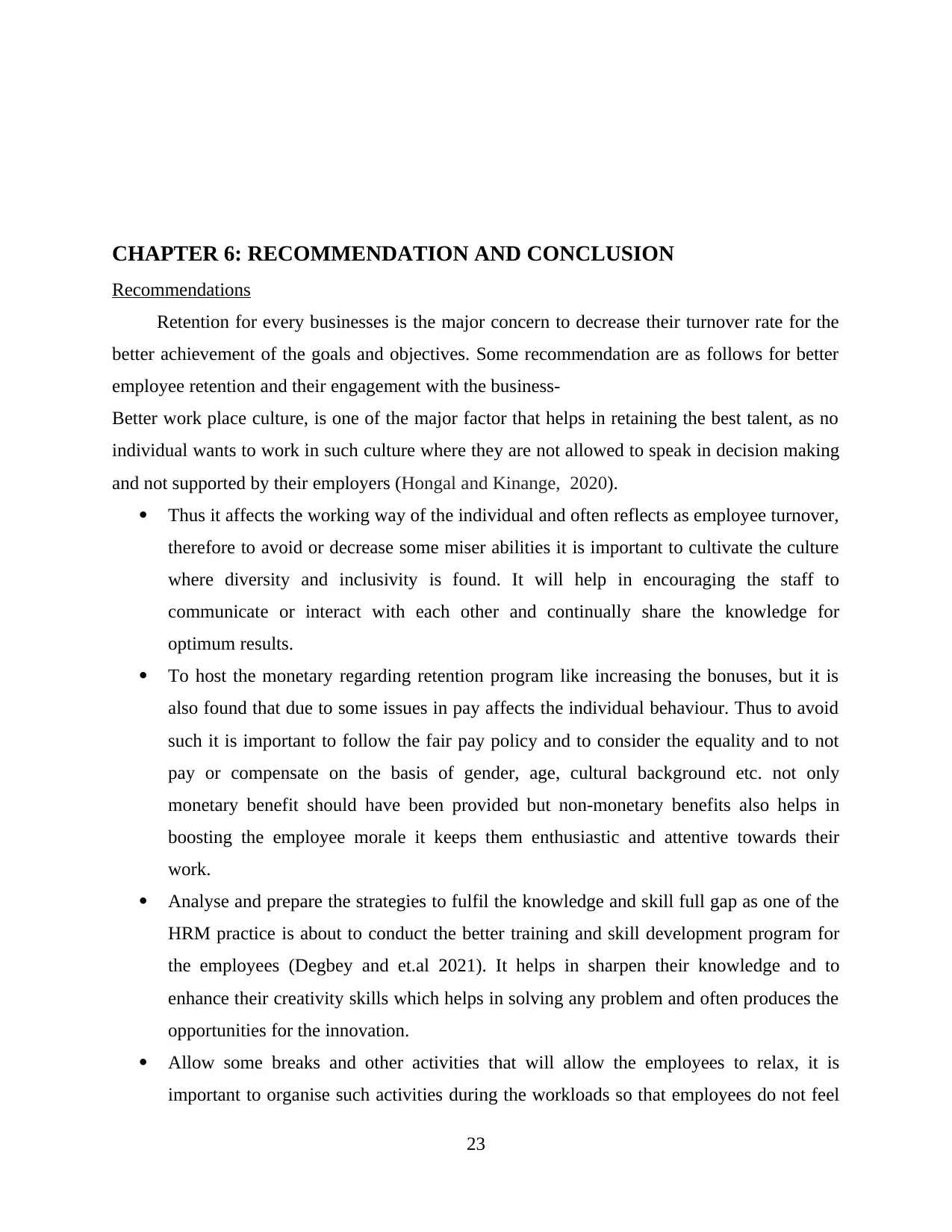
CHAPTER 6: RECOMMENDATION AND CONCLUSION
Recommendations
Retention for every businesses is the major concern to decrease their turnover rate for the
better achievement of the goals and objectives. Some recommendation are as follows for better
employee retention and their engagement with the business-
Better work place culture, is one of the major factor that helps in retaining the best talent, as no
individual wants to work in such culture where they are not allowed to speak in decision making
and not supported by their employers (Hongal and Kinange, 2020).
Thus it affects the working way of the individual and often reflects as employee turnover,
therefore to avoid or decrease some miser abilities it is important to cultivate the culture
where diversity and inclusivity is found. It will help in encouraging the staff to
communicate or interact with each other and continually share the knowledge for
optimum results.
To host the monetary regarding retention program like increasing the bonuses, but it is
also found that due to some issues in pay affects the individual behaviour. Thus to avoid
such it is important to follow the fair pay policy and to consider the equality and to not
pay or compensate on the basis of gender, age, cultural background etc. not only
monetary benefit should have been provided but non-monetary benefits also helps in
boosting the employee morale it keeps them enthusiastic and attentive towards their
work.
Analyse and prepare the strategies to fulfil the knowledge and skill full gap as one of the
HRM practice is about to conduct the better training and skill development program for
the employees (Degbey and et.al 2021). It helps in sharpen their knowledge and to
enhance their creativity skills which helps in solving any problem and often produces the
opportunities for the innovation.
Allow some breaks and other activities that will allow the employees to relax, it is
important to organise such activities during the workloads so that employees do not feel
23
Recommendations
Retention for every businesses is the major concern to decrease their turnover rate for the
better achievement of the goals and objectives. Some recommendation are as follows for better
employee retention and their engagement with the business-
Better work place culture, is one of the major factor that helps in retaining the best talent, as no
individual wants to work in such culture where they are not allowed to speak in decision making
and not supported by their employers (Hongal and Kinange, 2020).
Thus it affects the working way of the individual and often reflects as employee turnover,
therefore to avoid or decrease some miser abilities it is important to cultivate the culture
where diversity and inclusivity is found. It will help in encouraging the staff to
communicate or interact with each other and continually share the knowledge for
optimum results.
To host the monetary regarding retention program like increasing the bonuses, but it is
also found that due to some issues in pay affects the individual behaviour. Thus to avoid
such it is important to follow the fair pay policy and to consider the equality and to not
pay or compensate on the basis of gender, age, cultural background etc. not only
monetary benefit should have been provided but non-monetary benefits also helps in
boosting the employee morale it keeps them enthusiastic and attentive towards their
work.
Analyse and prepare the strategies to fulfil the knowledge and skill full gap as one of the
HRM practice is about to conduct the better training and skill development program for
the employees (Degbey and et.al 2021). It helps in sharpen their knowledge and to
enhance their creativity skills which helps in solving any problem and often produces the
opportunities for the innovation.
Allow some breaks and other activities that will allow the employees to relax, it is
important to organise such activities during the workloads so that employees do not feel
23

pressured as during such time they feel lots of work burden which affects their physical
as well as mental health. Therefore to allow them to take mandatory offs and mini breaks
from their work will help in increasing the employee interaction. It is also efficient in
maximising their engagement and to put exchanged knowledge in team work to increase
its efficiency.
It is the work demand to adapt the change in such it is the responsibility of the
management team to make their team efficient to adapt the change. It is their duty to
enable them to move forward change instead of considering as a obstacles. Therefore, in
such situation there are more chances for the employee turnover are found that affects the
business profitability. Thus management are required to support their employees as to
motivate them solve their problems to adapt the change and to set the individual goals
that guides in improvising in one self as well as for the business success.
Talent management process should also need to properly implemented for the desired
results, as it helps in keeping the supportive and innovative work place environment.
With the help of all these recommendations businesses can easily move forward to retain
their potential talent to increase their engagement within organisational resources.
CONCLUSION
From the above research project, it is concluded that Contemporary HRM practices helps
in employee retention and it also promotes the employee engagement that guides the business
towards profitability way. Above report has discussed the research methodologies, first it
discusses the aims and objective which proposed to cover, it also covered the literature review
section. In which different themes have been discussed where it includes the different author’s
perception over the research topic. It further covered the research strategies which concluded as
qualitative research type, further included that exploratory research design and inductive research
reasoning. This research project also described the interpritivism research philosophy that is
undertaken by the research analyst. It further covered the data collection section that covers the
secondary data analysis where the data have been taken from the books and journals. It also
covered the data analysis section which is done by discussing the themes that highlighted the
importance of HRM for the businesses and how it boost the organisational culture to make it goal
oriented and keeps engaging the employees to decrease the turnover rate.
as well as mental health. Therefore to allow them to take mandatory offs and mini breaks
from their work will help in increasing the employee interaction. It is also efficient in
maximising their engagement and to put exchanged knowledge in team work to increase
its efficiency.
It is the work demand to adapt the change in such it is the responsibility of the
management team to make their team efficient to adapt the change. It is their duty to
enable them to move forward change instead of considering as a obstacles. Therefore, in
such situation there are more chances for the employee turnover are found that affects the
business profitability. Thus management are required to support their employees as to
motivate them solve their problems to adapt the change and to set the individual goals
that guides in improvising in one self as well as for the business success.
Talent management process should also need to properly implemented for the desired
results, as it helps in keeping the supportive and innovative work place environment.
With the help of all these recommendations businesses can easily move forward to retain
their potential talent to increase their engagement within organisational resources.
CONCLUSION
From the above research project, it is concluded that Contemporary HRM practices helps
in employee retention and it also promotes the employee engagement that guides the business
towards profitability way. Above report has discussed the research methodologies, first it
discusses the aims and objective which proposed to cover, it also covered the literature review
section. In which different themes have been discussed where it includes the different author’s
perception over the research topic. It further covered the research strategies which concluded as
qualitative research type, further included that exploratory research design and inductive research
reasoning. This research project also described the interpritivism research philosophy that is
undertaken by the research analyst. It further covered the data collection section that covers the
secondary data analysis where the data have been taken from the books and journals. It also
covered the data analysis section which is done by discussing the themes that highlighted the
importance of HRM for the businesses and how it boost the organisational culture to make it goal
oriented and keeps engaging the employees to decrease the turnover rate.
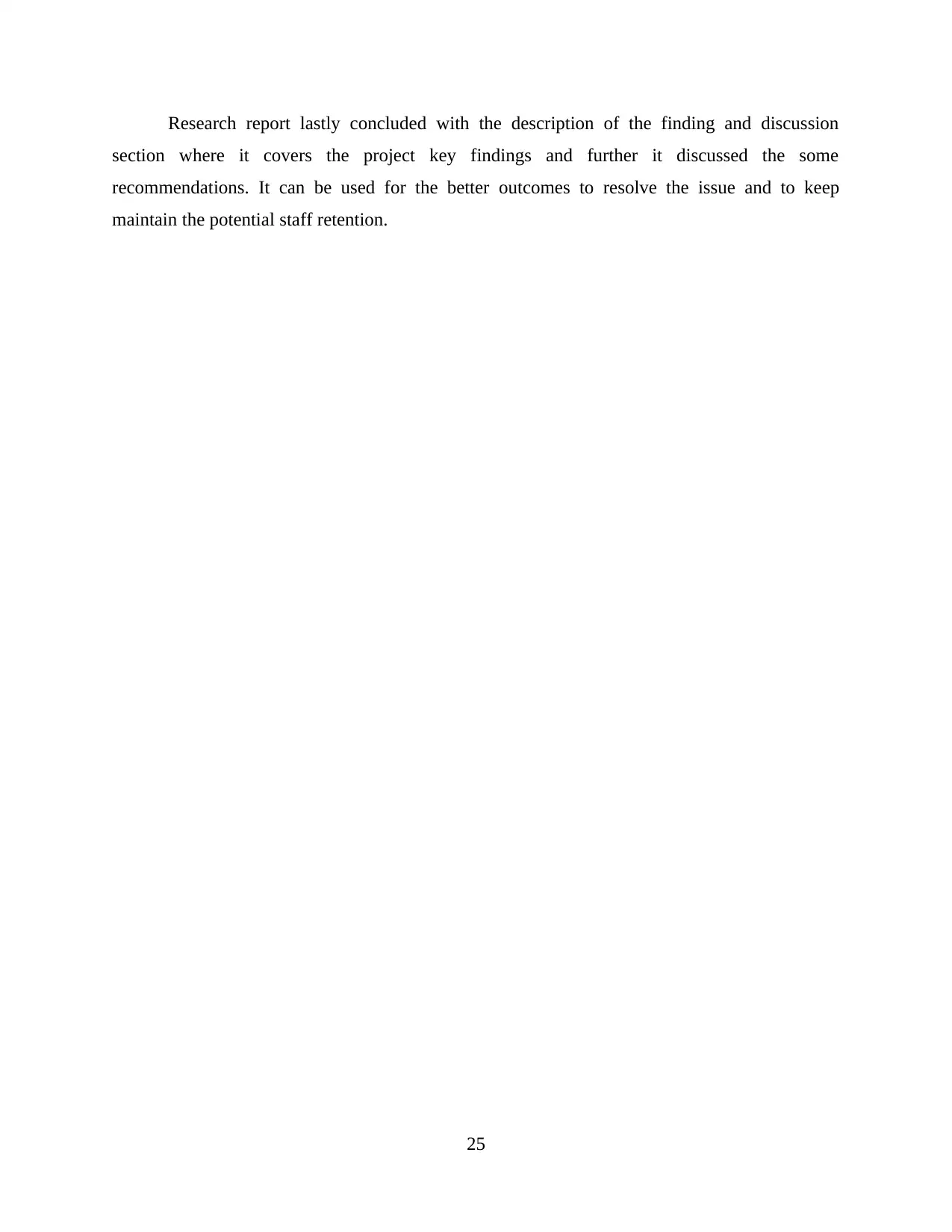
Research report lastly concluded with the description of the finding and discussion
section where it covers the project key findings and further it discussed the some
recommendations. It can be used for the better outcomes to resolve the issue and to keep
maintain the potential staff retention.
25
section where it covers the project key findings and further it discussed the some
recommendations. It can be used for the better outcomes to resolve the issue and to keep
maintain the potential staff retention.
25
Paraphrase This Document
Need a fresh take? Get an instant paraphrase of this document with our AI Paraphraser
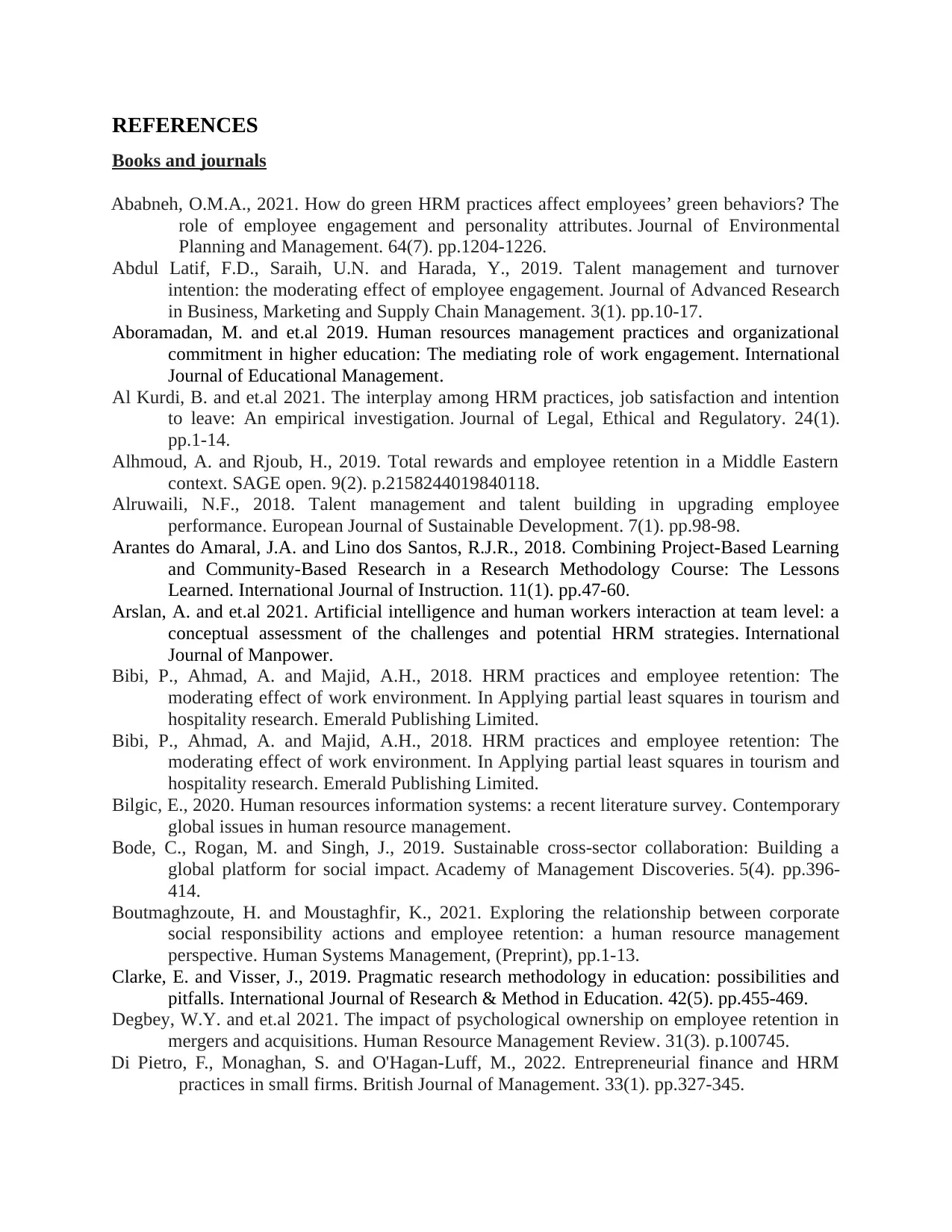
REFERENCES
Books and journals
Ababneh, O.M.A., 2021. How do green HRM practices affect employees’ green behaviors? The
role of employee engagement and personality attributes. Journal of Environmental
Planning and Management. 64(7). pp.1204-1226.
Abdul Latif, F.D., Saraih, U.N. and Harada, Y., 2019. Talent management and turnover
intention: the moderating effect of employee engagement. Journal of Advanced Research
in Business, Marketing and Supply Chain Management. 3(1). pp.10-17.
Aboramadan, M. and et.al 2019. Human resources management practices and organizational
commitment in higher education: The mediating role of work engagement. International
Journal of Educational Management.
Al Kurdi, B. and et.al 2021. The interplay among HRM practices, job satisfaction and intention
to leave: An empirical investigation. Journal of Legal, Ethical and Regulatory. 24(1).
pp.1-14.
Alhmoud, A. and Rjoub, H., 2019. Total rewards and employee retention in a Middle Eastern
context. SAGE open. 9(2). p.2158244019840118.
Alruwaili, N.F., 2018. Talent management and talent building in upgrading employee
performance. European Journal of Sustainable Development. 7(1). pp.98-98.
Arantes do Amaral, J.A. and Lino dos Santos, R.J.R., 2018. Combining Project-Based Learning
and Community-Based Research in a Research Methodology Course: The Lessons
Learned. International Journal of Instruction. 11(1). pp.47-60.
Arslan, A. and et.al 2021. Artificial intelligence and human workers interaction at team level: a
conceptual assessment of the challenges and potential HRM strategies. International
Journal of Manpower.
Bibi, P., Ahmad, A. and Majid, A.H., 2018. HRM practices and employee retention: The
moderating effect of work environment. In Applying partial least squares in tourism and
hospitality research. Emerald Publishing Limited.
Bibi, P., Ahmad, A. and Majid, A.H., 2018. HRM practices and employee retention: The
moderating effect of work environment. In Applying partial least squares in tourism and
hospitality research. Emerald Publishing Limited.
Bilgic, E., 2020. Human resources information systems: a recent literature survey. Contemporary
global issues in human resource management.
Bode, C., Rogan, M. and Singh, J., 2019. Sustainable cross-sector collaboration: Building a
global platform for social impact. Academy of Management Discoveries. 5(4). pp.396-
414.
Boutmaghzoute, H. and Moustaghfir, K., 2021. Exploring the relationship between corporate
social responsibility actions and employee retention: a human resource management
perspective. Human Systems Management, (Preprint), pp.1-13.
Clarke, E. and Visser, J., 2019. Pragmatic research methodology in education: possibilities and
pitfalls. International Journal of Research & Method in Education. 42(5). pp.455-469.
Degbey, W.Y. and et.al 2021. The impact of psychological ownership on employee retention in
mergers and acquisitions. Human Resource Management Review. 31(3). p.100745.
Di Pietro, F., Monaghan, S. and O'Hagan‐Luff, M., 2022. Entrepreneurial finance and HRM
practices in small firms. British Journal of Management. 33(1). pp.327-345.
Books and journals
Ababneh, O.M.A., 2021. How do green HRM practices affect employees’ green behaviors? The
role of employee engagement and personality attributes. Journal of Environmental
Planning and Management. 64(7). pp.1204-1226.
Abdul Latif, F.D., Saraih, U.N. and Harada, Y., 2019. Talent management and turnover
intention: the moderating effect of employee engagement. Journal of Advanced Research
in Business, Marketing and Supply Chain Management. 3(1). pp.10-17.
Aboramadan, M. and et.al 2019. Human resources management practices and organizational
commitment in higher education: The mediating role of work engagement. International
Journal of Educational Management.
Al Kurdi, B. and et.al 2021. The interplay among HRM practices, job satisfaction and intention
to leave: An empirical investigation. Journal of Legal, Ethical and Regulatory. 24(1).
pp.1-14.
Alhmoud, A. and Rjoub, H., 2019. Total rewards and employee retention in a Middle Eastern
context. SAGE open. 9(2). p.2158244019840118.
Alruwaili, N.F., 2018. Talent management and talent building in upgrading employee
performance. European Journal of Sustainable Development. 7(1). pp.98-98.
Arantes do Amaral, J.A. and Lino dos Santos, R.J.R., 2018. Combining Project-Based Learning
and Community-Based Research in a Research Methodology Course: The Lessons
Learned. International Journal of Instruction. 11(1). pp.47-60.
Arslan, A. and et.al 2021. Artificial intelligence and human workers interaction at team level: a
conceptual assessment of the challenges and potential HRM strategies. International
Journal of Manpower.
Bibi, P., Ahmad, A. and Majid, A.H., 2018. HRM practices and employee retention: The
moderating effect of work environment. In Applying partial least squares in tourism and
hospitality research. Emerald Publishing Limited.
Bibi, P., Ahmad, A. and Majid, A.H., 2018. HRM practices and employee retention: The
moderating effect of work environment. In Applying partial least squares in tourism and
hospitality research. Emerald Publishing Limited.
Bilgic, E., 2020. Human resources information systems: a recent literature survey. Contemporary
global issues in human resource management.
Bode, C., Rogan, M. and Singh, J., 2019. Sustainable cross-sector collaboration: Building a
global platform for social impact. Academy of Management Discoveries. 5(4). pp.396-
414.
Boutmaghzoute, H. and Moustaghfir, K., 2021. Exploring the relationship between corporate
social responsibility actions and employee retention: a human resource management
perspective. Human Systems Management, (Preprint), pp.1-13.
Clarke, E. and Visser, J., 2019. Pragmatic research methodology in education: possibilities and
pitfalls. International Journal of Research & Method in Education. 42(5). pp.455-469.
Degbey, W.Y. and et.al 2021. The impact of psychological ownership on employee retention in
mergers and acquisitions. Human Resource Management Review. 31(3). p.100745.
Di Pietro, F., Monaghan, S. and O'Hagan‐Luff, M., 2022. Entrepreneurial finance and HRM
practices in small firms. British Journal of Management. 33(1). pp.327-345.
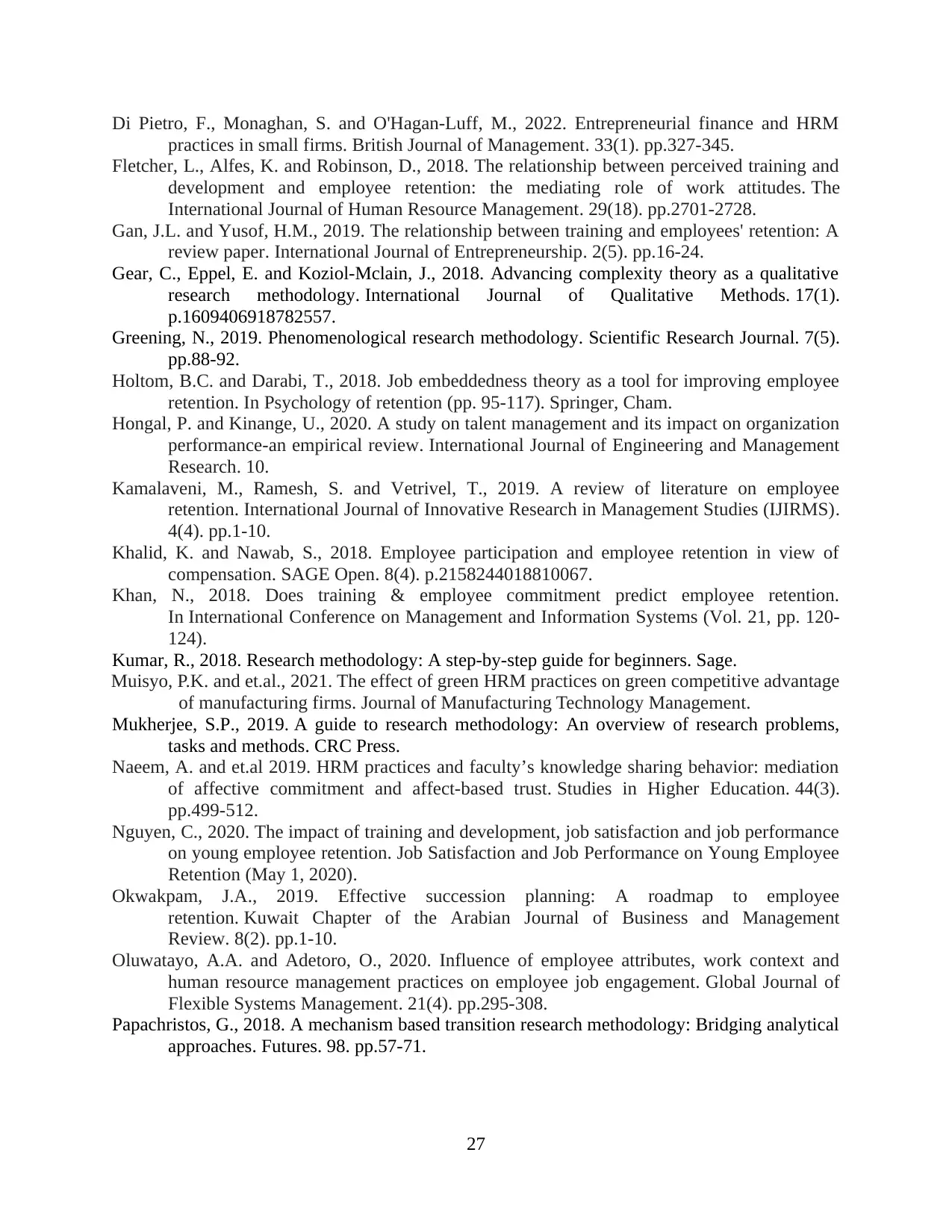
Di Pietro, F., Monaghan, S. and O'Hagan‐Luff, M., 2022. Entrepreneurial finance and HRM
practices in small firms. British Journal of Management. 33(1). pp.327-345.
Fletcher, L., Alfes, K. and Robinson, D., 2018. The relationship between perceived training and
development and employee retention: the mediating role of work attitudes. The
International Journal of Human Resource Management. 29(18). pp.2701-2728.
Gan, J.L. and Yusof, H.M., 2019. The relationship between training and employees' retention: A
review paper. International Journal of Entrepreneurship. 2(5). pp.16-24.
Gear, C., Eppel, E. and Koziol-Mclain, J., 2018. Advancing complexity theory as a qualitative
research methodology. International Journal of Qualitative Methods. 17(1).
p.1609406918782557.
Greening, N., 2019. Phenomenological research methodology. Scientific Research Journal. 7(5).
pp.88-92.
Holtom, B.C. and Darabi, T., 2018. Job embeddedness theory as a tool for improving employee
retention. In Psychology of retention (pp. 95-117). Springer, Cham.
Hongal, P. and Kinange, U., 2020. A study on talent management and its impact on organization
performance-an empirical review. International Journal of Engineering and Management
Research. 10.
Kamalaveni, M., Ramesh, S. and Vetrivel, T., 2019. A review of literature on employee
retention. International Journal of Innovative Research in Management Studies (IJIRMS).
4(4). pp.1-10.
Khalid, K. and Nawab, S., 2018. Employee participation and employee retention in view of
compensation. SAGE Open. 8(4). p.2158244018810067.
Khan, N., 2018. Does training & employee commitment predict employee retention.
In International Conference on Management and Information Systems (Vol. 21, pp. 120-
124).
Kumar, R., 2018. Research methodology: A step-by-step guide for beginners. Sage.
Muisyo, P.K. and et.al., 2021. The effect of green HRM practices on green competitive advantage
of manufacturing firms. Journal of Manufacturing Technology Management.
Mukherjee, S.P., 2019. A guide to research methodology: An overview of research problems,
tasks and methods. CRC Press.
Naeem, A. and et.al 2019. HRM practices and faculty’s knowledge sharing behavior: mediation
of affective commitment and affect-based trust. Studies in Higher Education. 44(3).
pp.499-512.
Nguyen, C., 2020. The impact of training and development, job satisfaction and job performance
on young employee retention. Job Satisfaction and Job Performance on Young Employee
Retention (May 1, 2020).
Okwakpam, J.A., 2019. Effective succession planning: A roadmap to employee
retention. Kuwait Chapter of the Arabian Journal of Business and Management
Review. 8(2). pp.1-10.
Oluwatayo, A.A. and Adetoro, O., 2020. Influence of employee attributes, work context and
human resource management practices on employee job engagement. Global Journal of
Flexible Systems Management. 21(4). pp.295-308.
Papachristos, G., 2018. A mechanism based transition research methodology: Bridging analytical
approaches. Futures. 98. pp.57-71.
27
practices in small firms. British Journal of Management. 33(1). pp.327-345.
Fletcher, L., Alfes, K. and Robinson, D., 2018. The relationship between perceived training and
development and employee retention: the mediating role of work attitudes. The
International Journal of Human Resource Management. 29(18). pp.2701-2728.
Gan, J.L. and Yusof, H.M., 2019. The relationship between training and employees' retention: A
review paper. International Journal of Entrepreneurship. 2(5). pp.16-24.
Gear, C., Eppel, E. and Koziol-Mclain, J., 2018. Advancing complexity theory as a qualitative
research methodology. International Journal of Qualitative Methods. 17(1).
p.1609406918782557.
Greening, N., 2019. Phenomenological research methodology. Scientific Research Journal. 7(5).
pp.88-92.
Holtom, B.C. and Darabi, T., 2018. Job embeddedness theory as a tool for improving employee
retention. In Psychology of retention (pp. 95-117). Springer, Cham.
Hongal, P. and Kinange, U., 2020. A study on talent management and its impact on organization
performance-an empirical review. International Journal of Engineering and Management
Research. 10.
Kamalaveni, M., Ramesh, S. and Vetrivel, T., 2019. A review of literature on employee
retention. International Journal of Innovative Research in Management Studies (IJIRMS).
4(4). pp.1-10.
Khalid, K. and Nawab, S., 2018. Employee participation and employee retention in view of
compensation. SAGE Open. 8(4). p.2158244018810067.
Khan, N., 2018. Does training & employee commitment predict employee retention.
In International Conference on Management and Information Systems (Vol. 21, pp. 120-
124).
Kumar, R., 2018. Research methodology: A step-by-step guide for beginners. Sage.
Muisyo, P.K. and et.al., 2021. The effect of green HRM practices on green competitive advantage
of manufacturing firms. Journal of Manufacturing Technology Management.
Mukherjee, S.P., 2019. A guide to research methodology: An overview of research problems,
tasks and methods. CRC Press.
Naeem, A. and et.al 2019. HRM practices and faculty’s knowledge sharing behavior: mediation
of affective commitment and affect-based trust. Studies in Higher Education. 44(3).
pp.499-512.
Nguyen, C., 2020. The impact of training and development, job satisfaction and job performance
on young employee retention. Job Satisfaction and Job Performance on Young Employee
Retention (May 1, 2020).
Okwakpam, J.A., 2019. Effective succession planning: A roadmap to employee
retention. Kuwait Chapter of the Arabian Journal of Business and Management
Review. 8(2). pp.1-10.
Oluwatayo, A.A. and Adetoro, O., 2020. Influence of employee attributes, work context and
human resource management practices on employee job engagement. Global Journal of
Flexible Systems Management. 21(4). pp.295-308.
Papachristos, G., 2018. A mechanism based transition research methodology: Bridging analytical
approaches. Futures. 98. pp.57-71.
27
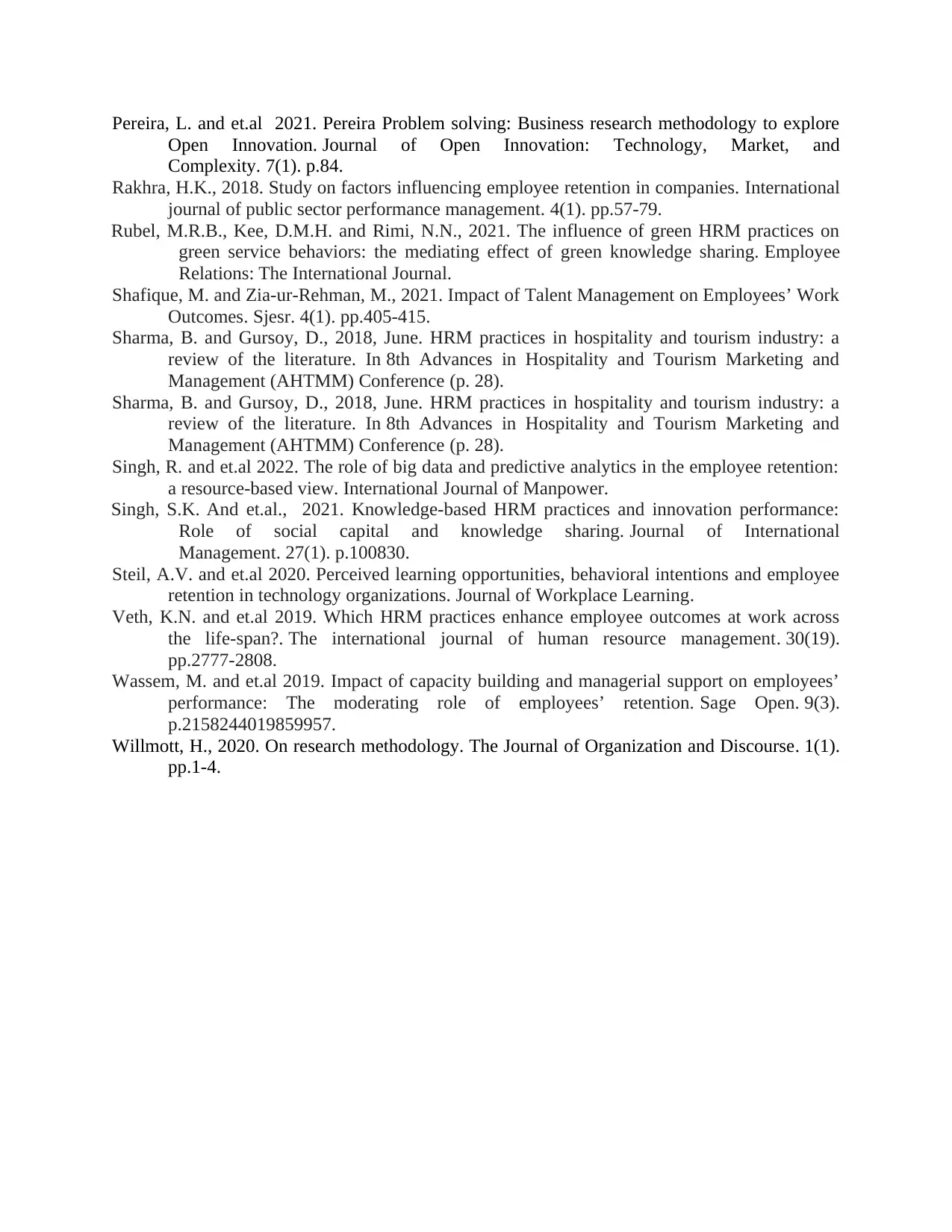
Pereira, L. and et.al 2021. Pereira Problem solving: Business research methodology to explore
Open Innovation. Journal of Open Innovation: Technology, Market, and
Complexity. 7(1). p.84.
Rakhra, H.K., 2018. Study on factors influencing employee retention in companies. International
journal of public sector performance management. 4(1). pp.57-79.
Rubel, M.R.B., Kee, D.M.H. and Rimi, N.N., 2021. The influence of green HRM practices on
green service behaviors: the mediating effect of green knowledge sharing. Employee
Relations: The International Journal.
Shafique, M. and Zia-ur-Rehman, M., 2021. Impact of Talent Management on Employees’ Work
Outcomes. Sjesr. 4(1). pp.405-415.
Sharma, B. and Gursoy, D., 2018, June. HRM practices in hospitality and tourism industry: a
review of the literature. In 8th Advances in Hospitality and Tourism Marketing and
Management (AHTMM) Conference (p. 28).
Sharma, B. and Gursoy, D., 2018, June. HRM practices in hospitality and tourism industry: a
review of the literature. In 8th Advances in Hospitality and Tourism Marketing and
Management (AHTMM) Conference (p. 28).
Singh, R. and et.al 2022. The role of big data and predictive analytics in the employee retention:
a resource-based view. International Journal of Manpower.
Singh, S.K. And et.al., 2021. Knowledge-based HRM practices and innovation performance:
Role of social capital and knowledge sharing. Journal of International
Management. 27(1). p.100830.
Steil, A.V. and et.al 2020. Perceived learning opportunities, behavioral intentions and employee
retention in technology organizations. Journal of Workplace Learning.
Veth, K.N. and et.al 2019. Which HRM practices enhance employee outcomes at work across
the life-span?. The international journal of human resource management. 30(19).
pp.2777-2808.
Wassem, M. and et.al 2019. Impact of capacity building and managerial support on employees’
performance: The moderating role of employees’ retention. Sage Open. 9(3).
p.2158244019859957.
Willmott, H., 2020. On research methodology. The Journal of Organization and Discourse. 1(1).
pp.1-4.
Open Innovation. Journal of Open Innovation: Technology, Market, and
Complexity. 7(1). p.84.
Rakhra, H.K., 2018. Study on factors influencing employee retention in companies. International
journal of public sector performance management. 4(1). pp.57-79.
Rubel, M.R.B., Kee, D.M.H. and Rimi, N.N., 2021. The influence of green HRM practices on
green service behaviors: the mediating effect of green knowledge sharing. Employee
Relations: The International Journal.
Shafique, M. and Zia-ur-Rehman, M., 2021. Impact of Talent Management on Employees’ Work
Outcomes. Sjesr. 4(1). pp.405-415.
Sharma, B. and Gursoy, D., 2018, June. HRM practices in hospitality and tourism industry: a
review of the literature. In 8th Advances in Hospitality and Tourism Marketing and
Management (AHTMM) Conference (p. 28).
Sharma, B. and Gursoy, D., 2018, June. HRM practices in hospitality and tourism industry: a
review of the literature. In 8th Advances in Hospitality and Tourism Marketing and
Management (AHTMM) Conference (p. 28).
Singh, R. and et.al 2022. The role of big data and predictive analytics in the employee retention:
a resource-based view. International Journal of Manpower.
Singh, S.K. And et.al., 2021. Knowledge-based HRM practices and innovation performance:
Role of social capital and knowledge sharing. Journal of International
Management. 27(1). p.100830.
Steil, A.V. and et.al 2020. Perceived learning opportunities, behavioral intentions and employee
retention in technology organizations. Journal of Workplace Learning.
Veth, K.N. and et.al 2019. Which HRM practices enhance employee outcomes at work across
the life-span?. The international journal of human resource management. 30(19).
pp.2777-2808.
Wassem, M. and et.al 2019. Impact of capacity building and managerial support on employees’
performance: The moderating role of employees’ retention. Sage Open. 9(3).
p.2158244019859957.
Willmott, H., 2020. On research methodology. The Journal of Organization and Discourse. 1(1).
pp.1-4.
1 out of 28
Your All-in-One AI-Powered Toolkit for Academic Success.
+13062052269
info@desklib.com
Available 24*7 on WhatsApp / Email
![[object Object]](/_next/static/media/star-bottom.7253800d.svg)
Unlock your academic potential
© 2024 | Zucol Services PVT LTD | All rights reserved.



